63 Inspiring Keeping Room Ideas for a Cozy and Stylish Home

What makes a simple keeping room extraordinary and modern while improving form and function? Why are designers today using the concept of keeping rooms with no transitions with bold statements and elegant decor? In this post, I want to share inspiring keeping room layouts ideas for modern homes. From furniture to architectural ceilings, these keeping room ideas will help create a practical and inviting designer space. Modern designs don’t sacrifice appeal for functionality. These ideas are helpful if you’re looking to remodel or refresh your home.
Creating A Designer Keeping Room With Seamless Kitchen Integration
One of the most satisfying solutions I’ve implemented is combining the keeping room with the kitchen. This design ensures circulation in the space is social while meal preparation or entertaining is happening. This open-concept layout generates a welcoming ambiance and a visually harmonious flow throughout the home. In this case, neutral colors do the job, and harmonious flooring and trim changes define the boundaries between spaces. This way, the keeping room won’t feel like an independent unit or box, but an adaptation to the kitchen and modular living.
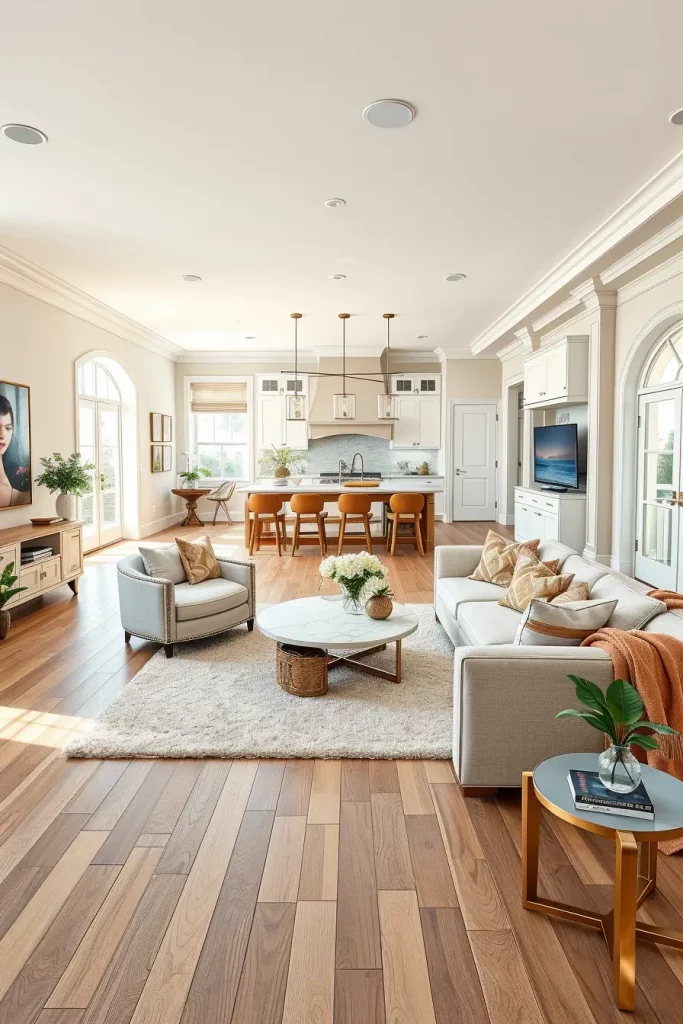
My choice of furniture always works well with the cabinetry and finishes of the kitchen. The low-profile sectionals, streamlined accent chair, and contemporary coffee table foster a muted conversation between the two spaces. Soft area rugs serve as boundaries which define zones while still retaining circulation. This continuity is further enhanced when matching or coordinating materials, such as natural oak and matte black hardware, are used.

Clients appreciate how this design balances family life and social gatherings. I commonly bring up examples from Architectural Digest or Studio McGee features where seamless integration is highlighted, demonstrating its added value in terms of beauty and everyday functionality. A kitchen-adjacent keeping room should feel like a natural retreat.
What would greatly enhance this design is employing hidden storage solutions or built-in benches to allow for more flexible seating. These frankly functional additions can heighten utility without disturbing the clean designer lines.
Focus on Modern Keeping Rooms With Statement Fireplaces
Every sophisticated keeping room must include a fireplace that provides aesthetic weight as well as functional warmth. I love the way a beautifully designed statement fireplace captures attention instantly giving a room’s furniture arrangement a visual anchor. The floor to ceiling stone, oversized mantels, or gas designs with minimalist linear features elevate the space from memorable to absolutely unforgettable.
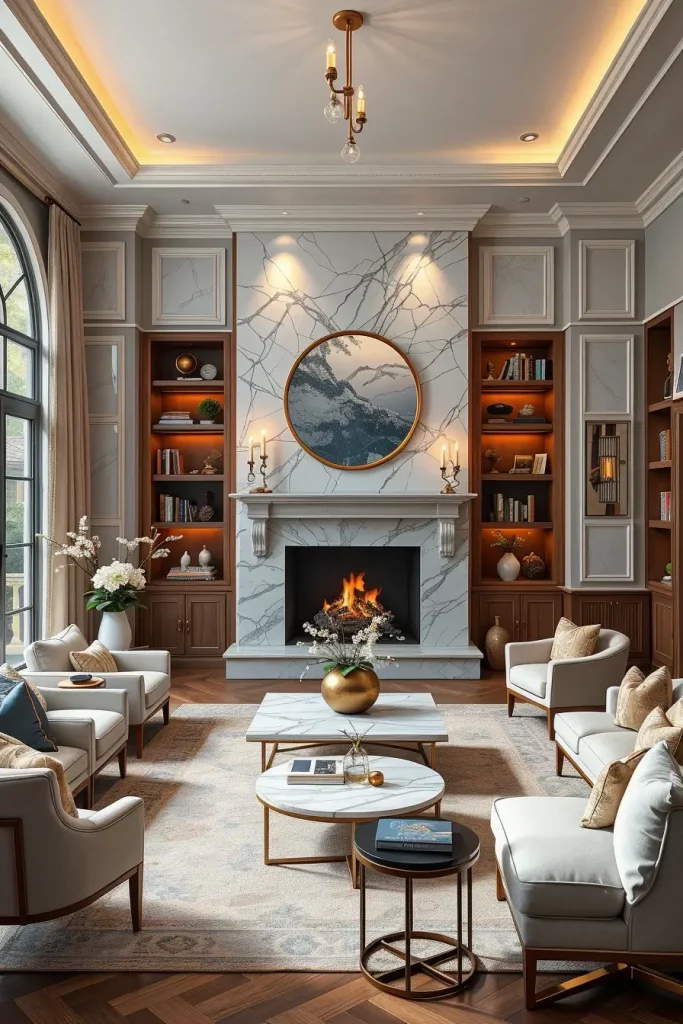
I usually prefer getting marble or textured plaster surrounds. Vertical bookshelves or art niches flanking the fireplace add to its elegance without losing the overall balance of the space. A fireplace finished in matte black or smooth cement also makes a striking modern accent, beautifully contrasting warm or neutral walls.
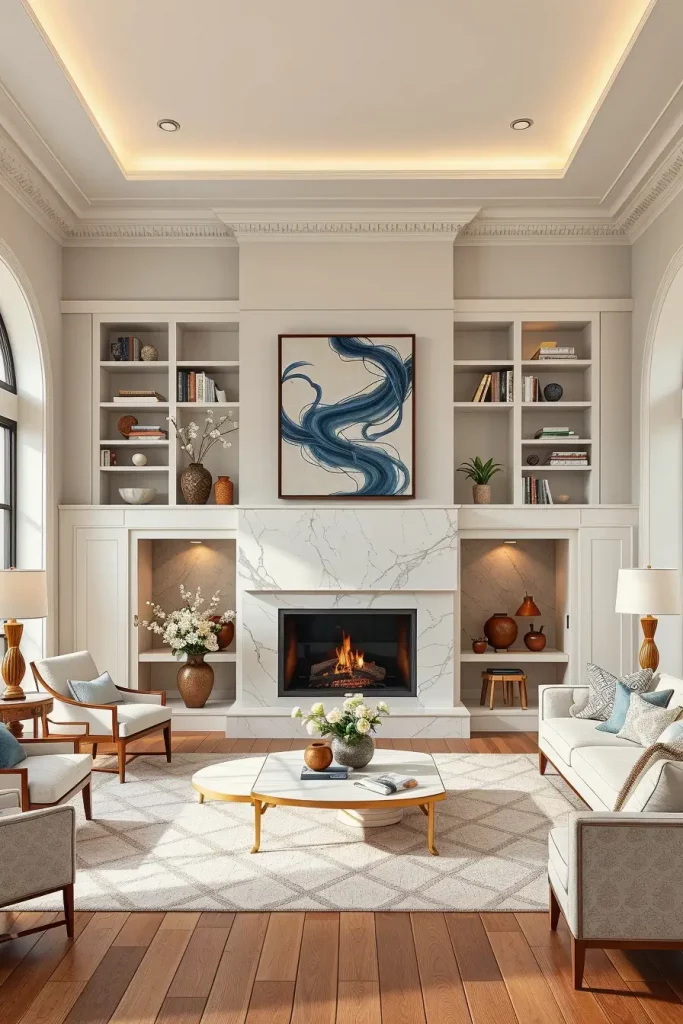
The fireplace becomes more than a source of warmth, it’s a story—one that I explore in my design projects. Following moments from Elle Decor, I suggest always layering the mantel with minimal objects or using art that can be changed with the seasons for a lighter seasonal feel.
For this section, I would argue that adding spotlights above the mantel or creating a subtle firewood niche nearby maintains interest without overwhelming the eye. These changes greatly enhance how the fireplace wall can be viewed and used.
Choosing Sophisticated Furnishings For A Polished Look
A keeping room’s sophistication is derived from the furniture first. Pieces with sophisticated appeal without compromising comfort are a priority for me. What also ensures for livable luxury is curved furniture with deep upholstery and designer fabrics. British upholstered pieces also encourages a sense of order instead of casual assembly.
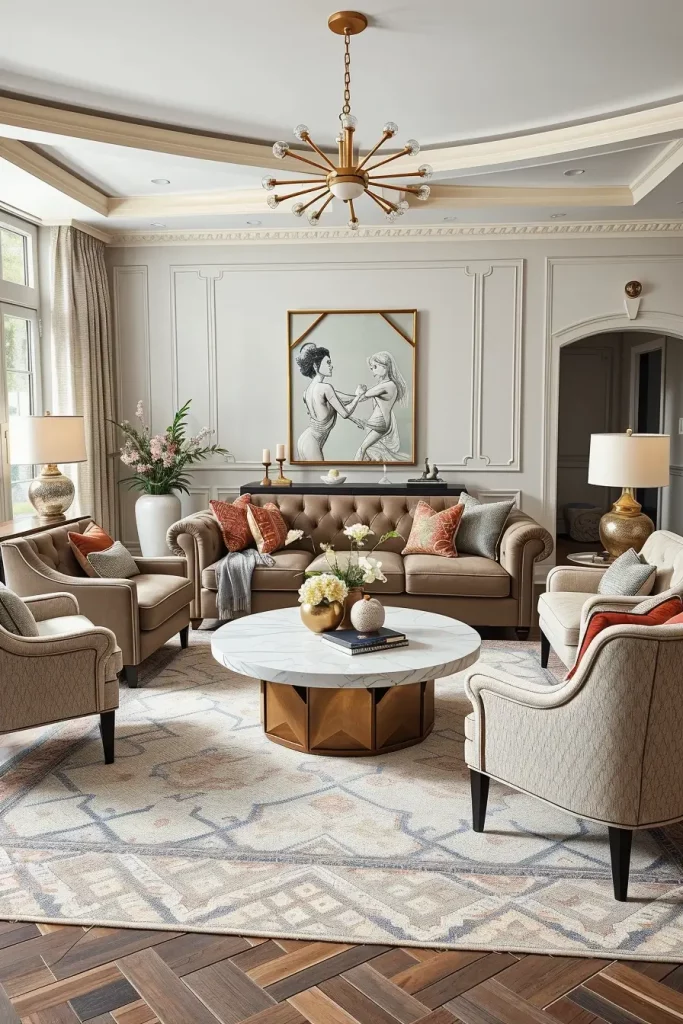
A tufted velvet sofa in soft taupe or navy, paired with accent chairs in leather or boucle, creates a perfect match. A low glass or marble-top coffee table adds lightness and contrast. For balance and flexibility, I add sculptural benches and pairs of ottomans. Such layered thoughtful choices drive modern, designer spaces.
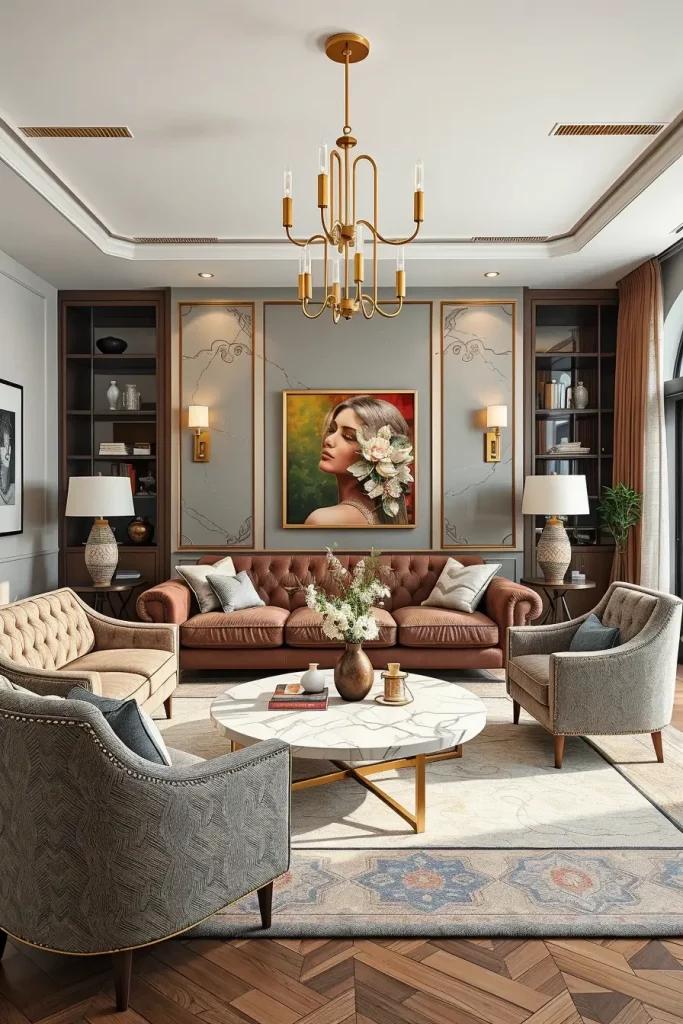
One suggestion I always follow from Veranda Magazine is to utilize three tiers of seating—a sofa, chairs, and occasional stools—as a way to maintain eye-level harmony and still provide space for conversations. It achieves a warm inviting feel that appeals to today’s luxury spaces.
Polished accents are sure to enhance such design, so I would refine this section by suggesting unique vintage accent pieces or bespoke upholstery that reflect the different personalities in the home without disrupting the pristine look.
Architectural Ceilings That Elevate Keeping Room Aesthetic
A stunning ceiling can completely transform the keeping room. When I want a room to feel taller and richer, mentally and architecturally, my focus is what’s above. Beamed, coffered, or even vaulted, ceilings add defining sophistication to a space. They form a visual canopy bringing balance, scale, and proportion into harmony with the function of the room.
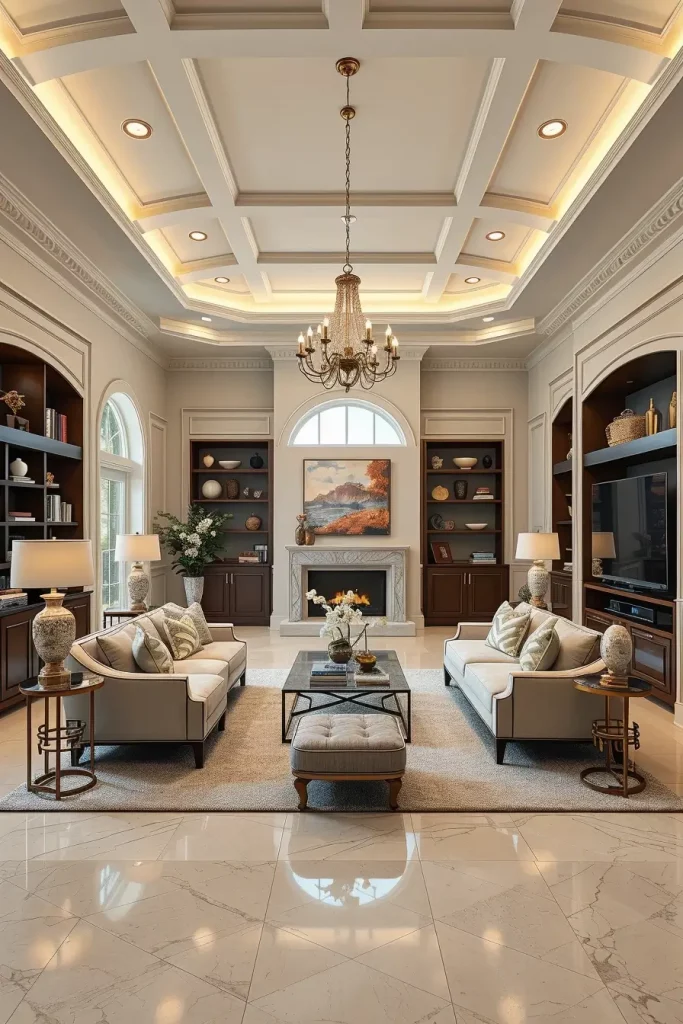
When trying to help my clients achieve a modern look, I usually recommend whitewashed wood beams, painted coffered ceilings, and tray ceilings with cove lights. These features can be accented with contrasting color wall paint or minimalistic crown moldings that emphasize the depth. The right materials also matter, for example: reclaimed wood, soft plaster, or light metallics for the ornamental light trays.
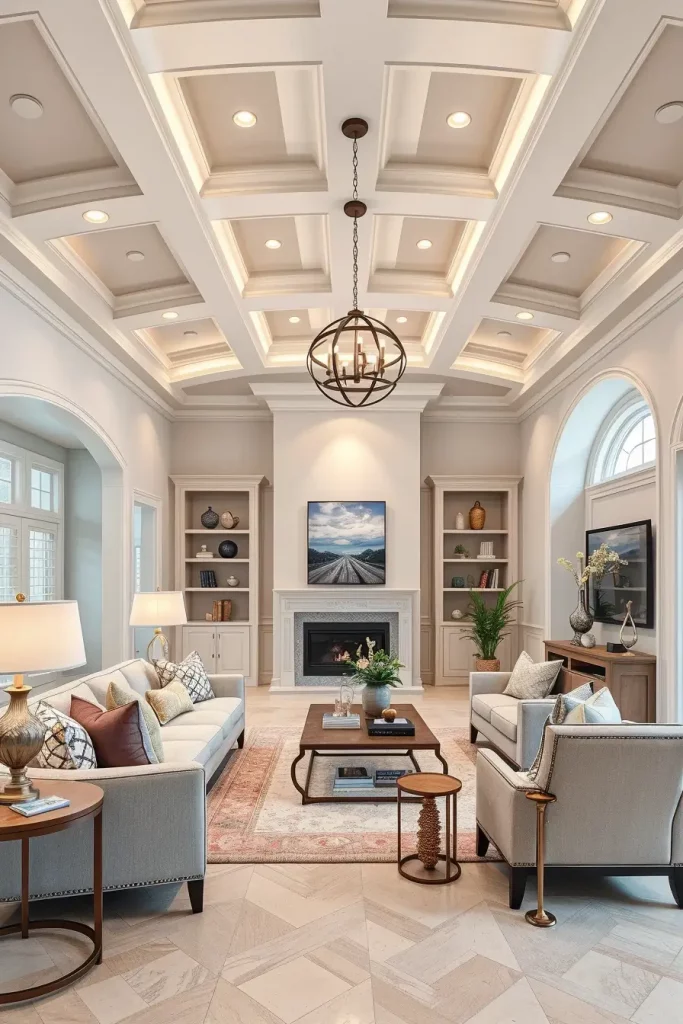
Until I show them the examples from House Beautiful or Dwell, most of my clients don’t pay attention to the ceiling. Once they notice, they understand how it plays an integral part. Flooring isn’t the only thing that matters; luxury is found in every plane of the room.
Laser silencers mounted on the walls or invisibly integrated smart LED lights would add a significant upgrade by seamlessly placing tech into the design. This is added in my new constructions or complete renovations.
Keeping Room Layouts That Prioritize Flow And Function
Keeping an effortless flow while strategically arranging furniture is the first step I take while designing a keeping room. A well organized room promotes ease of movement, interaction, and relaxation. In contemporary keeping rooms, I focus on the flowing symmetry of pathways, and furniture arrangements that support relaxed lounging as well as sophisticated entertaining. This equilibrium maintains a strong space to conduct daily activities.

I usually incorporate a primary conversation area with a sofa and armchairs grouped on a rug. Floating furniture—meaning nothing is shoved up against the walls—allows the room to breathe. I frequently employ console tables placed behind sofas, screen dividers or room dividers if the living room is adjoining with the kitchen or hallway, to blend the two areas.
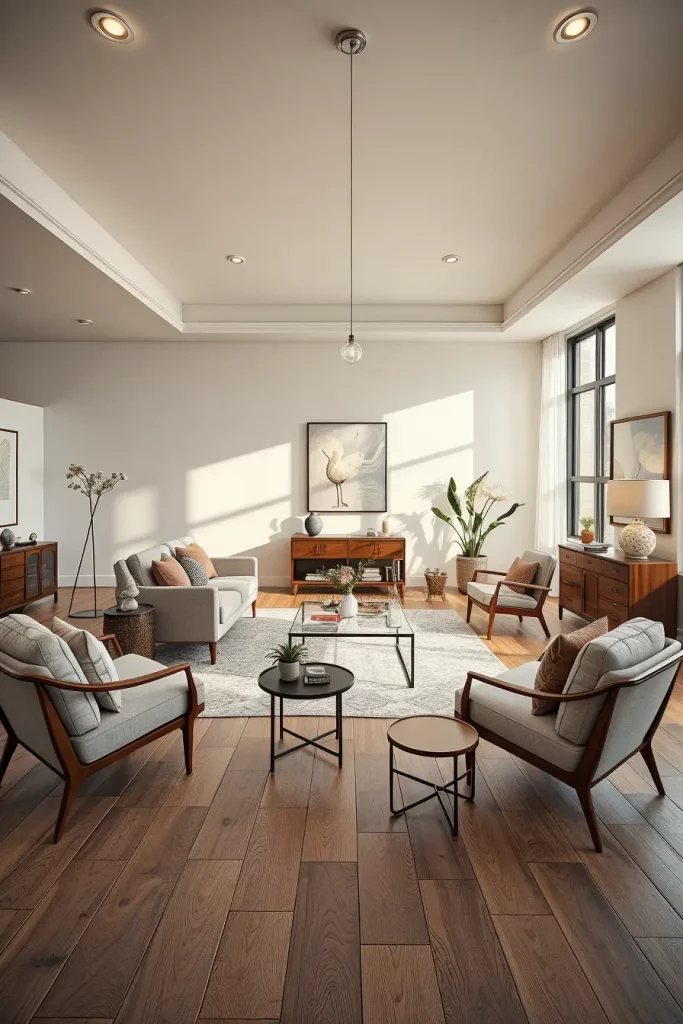
In my experience, layout is the single most underestimated element by homeowners. Smart designs look good and work with your life. An article I read in Domino and HGTV Magazine asserted something similar—they stressed the importance of function before form. You need to plan how you will use the room before decorating.
For this suggestion to be effective, I propose testing layouts using augmented reality apps or with masking tape. It saves time and ensures everything flows as planned in reality.
Neutrals, Mute Jewel Tones, Grays For Modern Elegance
The entire keeping room’s color can set its atmosphere. Each and every single one of my preferred color combinations invokes a sense on calmness and sophistication. I go for warm neutral living room colors, muted jewel tones, soft gray, and other navy accents to evoke an overall calm and confident setting. These hues create a sophisticated and timeless blush foundation that works beautifully with both layered and minimalist decor. Combining these colors with natural textures and metals results to serenity with an elevated touch.
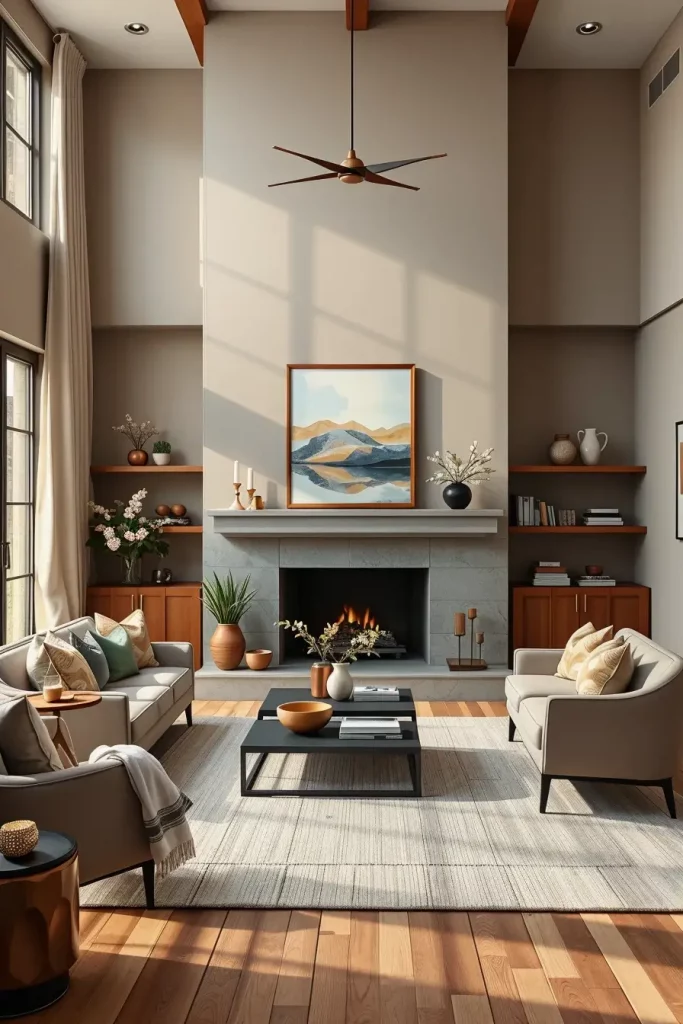
My preferred pairings are greige walls enriched with navy or olive accents, cream upholstery accentuated by dark timber or black metals, subdued mauves for a touch of femininity, and dark wood features. I also appreciate subtle shades of the same color within textiles, such as linen, velvet and bouclé in one hue, which can exude richness without being overly ostentatious.
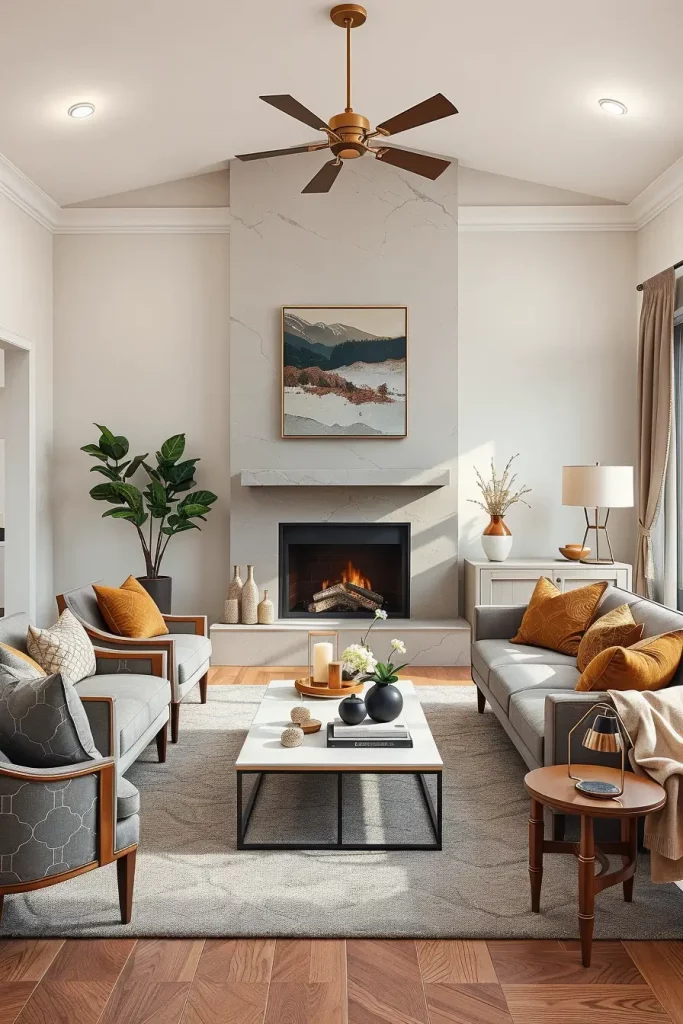
To better back my statement, Better Homes & Gardens notes that a well coordinated color palette is beneficial in making a room feel larger and more soothing. From my professional experience, colors are by far the most important element in any space to make it “designer.”
To achieve that, I may add color drenching, a more recent trend where walls and trim or even ceilings are painted the same or similar colors, which adds a more cohesive appearance. It can be quite bold, but if executed well, can be very elegant.
Designer Light Fixtures That Define The Space
Lighting should not only be functional, but rather an eye catching detail. In any polished keeping room, I consider lighting to be the necklace of a well tailored dress: it will complement and draw focus to the ensemble. Sculptural chandeliers, minimalist pendants, or artistic sconces; the right fixture brings life and sophistication to the space. I implement all types of lighting: ambient, task, and accent, to ensure every element is covered.
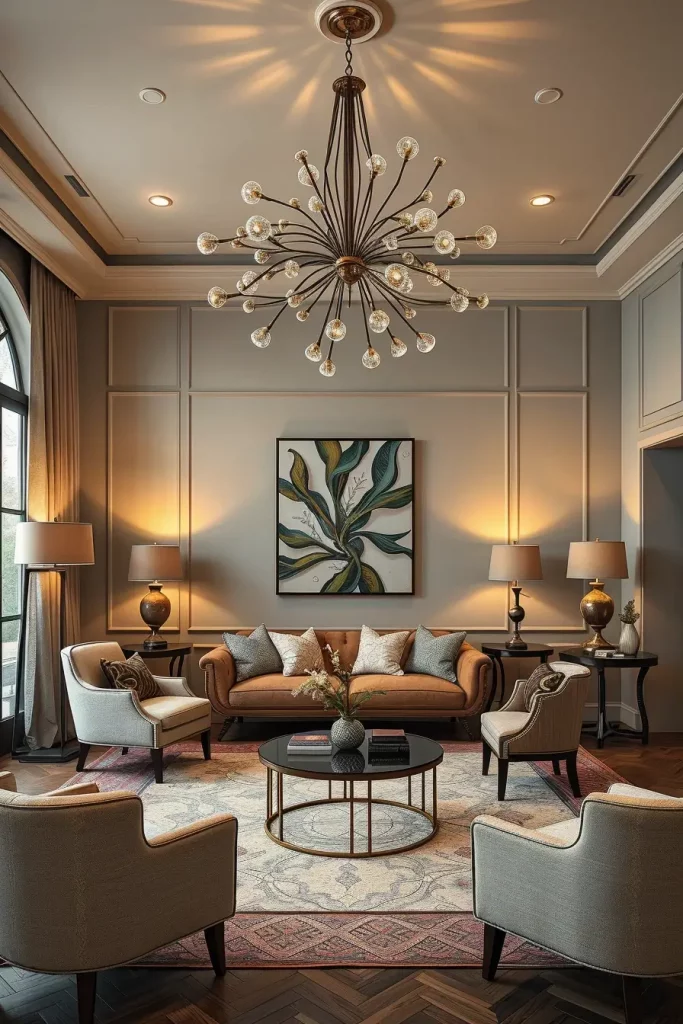
I usually suggest placing a globe or linear modern chandelier above the coffee table as the central light fixture. A wall sconce or floor lamp adds warmth and to the light. For flexibility, I prefer dimmable options with warm LED tones and for elegance, soft lighting.
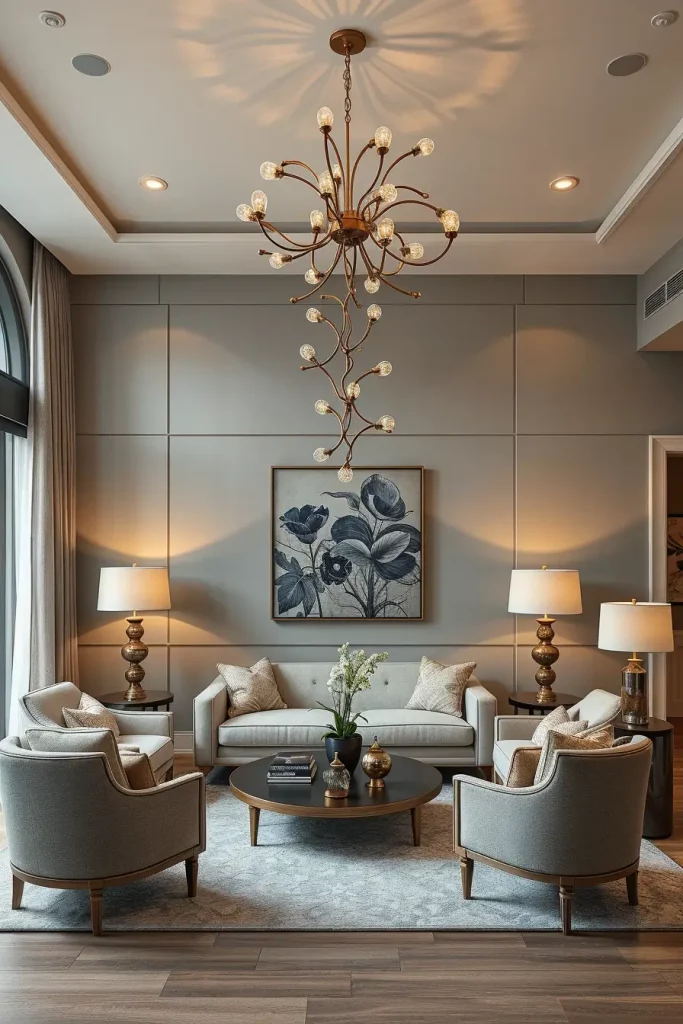
Luxe Interiors + Design features homes that showcase lighting as the focal point of the room. I draw from those features in order to elevate each project I touch. Lighting is not the last detail to be added, instead it is the mood and personality of the space.
What many designs are missing is having control over the lighting. For effortless elegance, smart switches or even motion sensors are extremely useful and I always recommend adding those. It is a hidden luxury that is worth its investment, especially when used often.
Artwork to Enrich Impression and Elegance of Space
Curated artwork is one of the most effective ways to personalize a keeping room. Art infuses depth as well as conversation and brings in character to any space. In a room where people seek comfort and connection, thoughtfully selected pieces further enhance the value of the environment’s emotional appeal. Personally, I tend to favor gallery-style walls with oversized statement canvases or sculptural wall pieces in complimentary color palettes integrated with the architectural details of the modern keeping room.
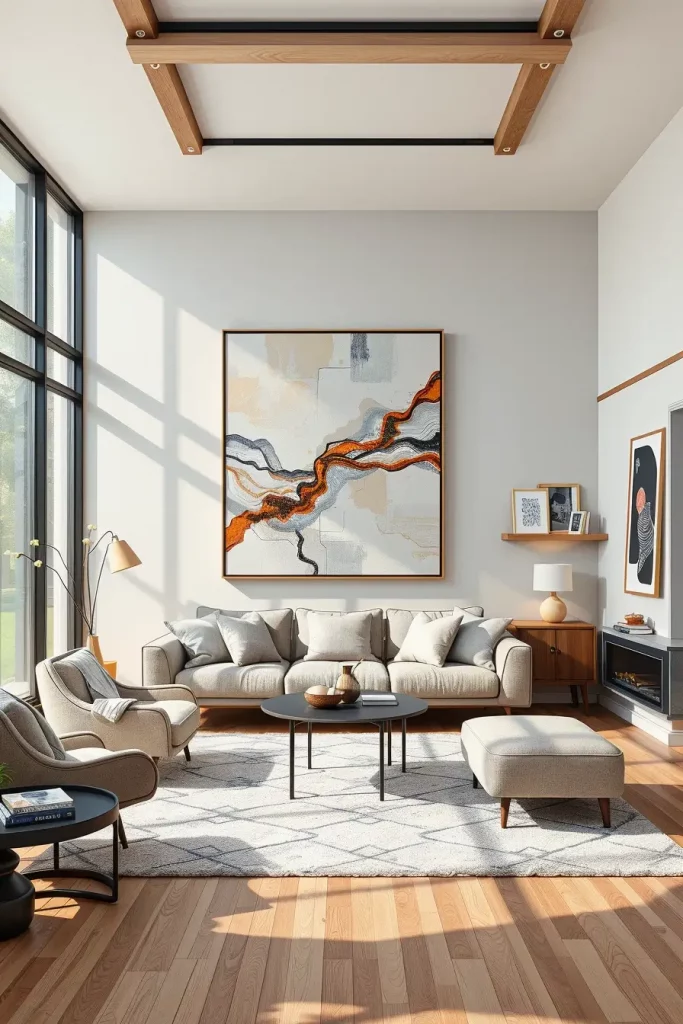
For instance, I prefer large neutral or monochrome abstract and nature-inspired pieces. Dimensional framed photography or mixed-media art which does not dominate the space is also appealing. Furthermore, small snapshot works framed on floating ledges can be arranged to create dynamic layering. For the frames, I tend to use natural wood and brass or black to incorporate other design features of the room.
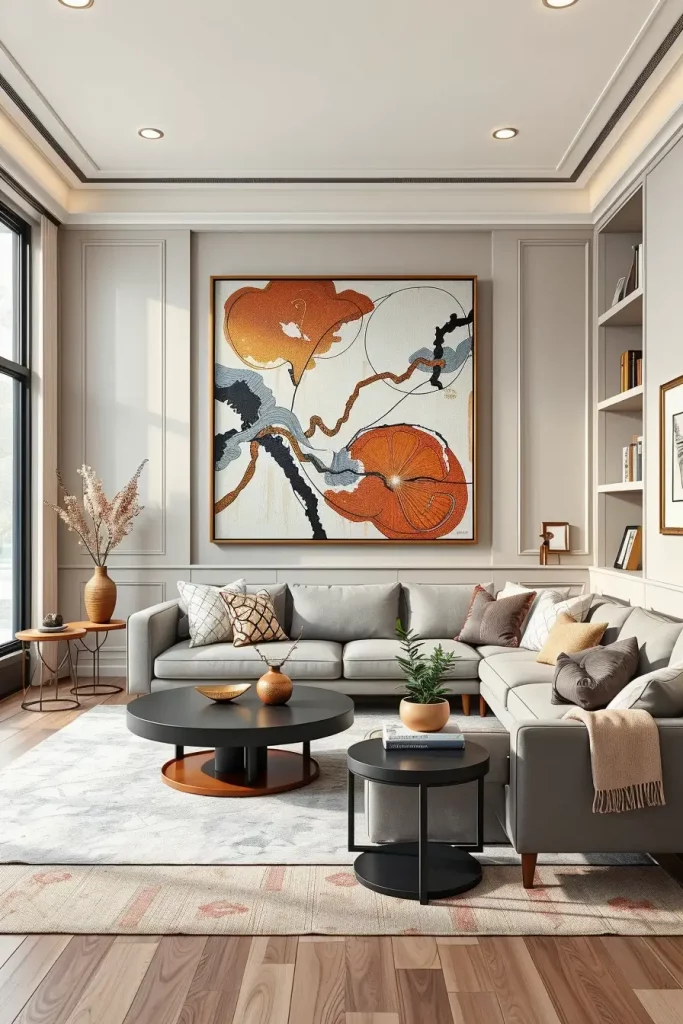
In my experience, art is one of the last considerations for most clients – but it is the first thing that effortlessly elevates the space with a touch of designer sophistication. Interiors where a single bold piece utterly transforms a room are frequently featured by Architectural Digest. I have taken inspiration from them in countless projects to achieve similar impact.
I would claim that additional uplighting or art lights can be added to emphasize certain pivotal pieces, which would amplify the subtle drama as well as the artistic nature of the display.
Combining Different Materials For Added Depth And Visual Appeal
In my eyes, for a refined keeping room, it is not enough to provide visual appeal; there has to be a certain tactile appeal as well. For this reason, I advocate mixing materials strenuously because wood, leather, stone, glass, and even soft textiles all contribute a lot when it comes to creating depth. The materials also provide warmth and richness which is crucial for a space that is supposed to sophisticated yet inviting.
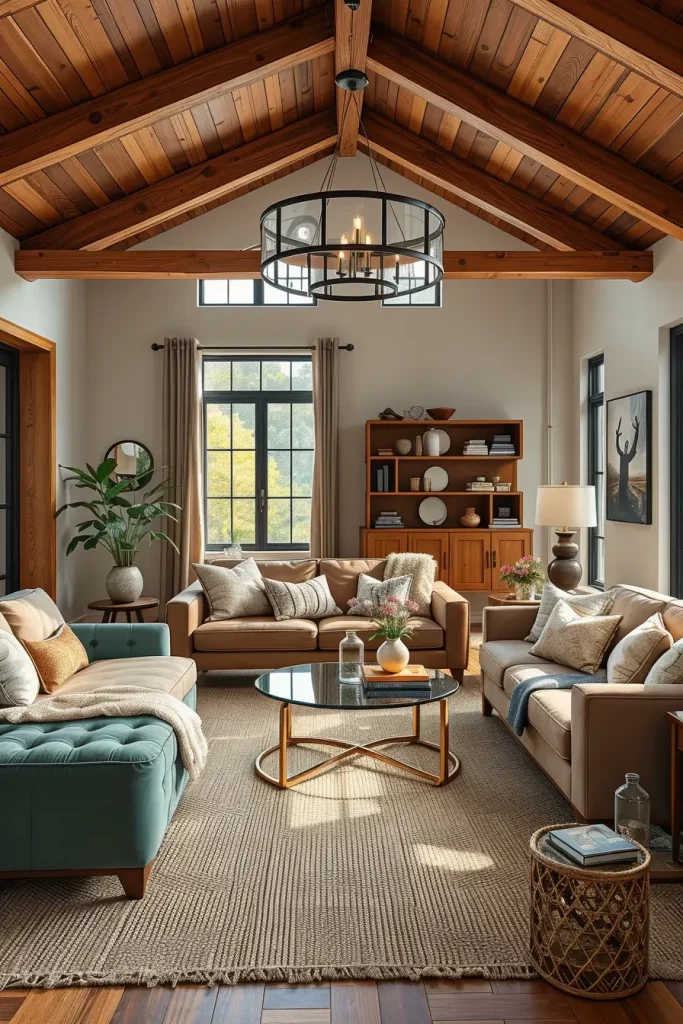
For example, I often pair a plush velvet sofa with a leather ottoman and a glass or travertine coffee table. To soften the look, I add linen drapery and a boucle throw along with a natural jute rug. This combination greatly enhances tactile interaction in the space. Architectural warmth is added through wooden elements like beamed ceilings or open shelving.
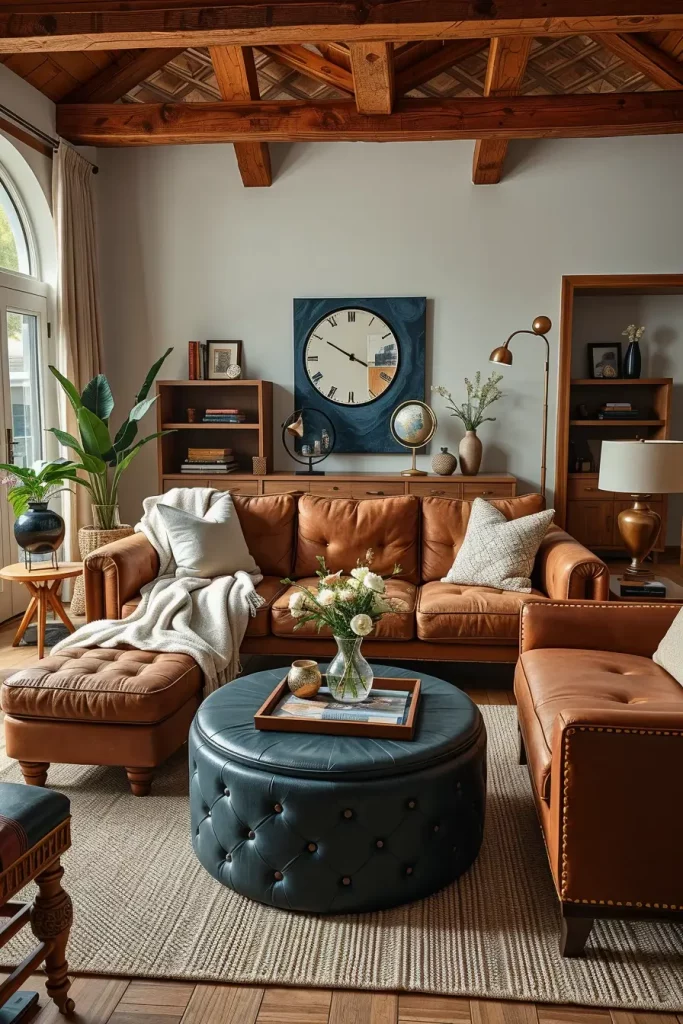
I have always admired one idea from Studio McGee. Every room is designed with a precise blend of hard and soft elements in perfect balance. It is their approach that inspires me to achieve the overall balance without compromising on contrast, and comfortable warmth. Luxurious warmth is what makes the room feel touchable, and inviting.
To finish off this concept, I would add wall paneling or a feature wallpaper on the back of each element to amplify the layering, adding a quiet, structural backdrop to the layering of features.
Accent Walls With Custom Wood Work Or Stone Finish
We are witnessing a new wave of accent walls and in the case of a modern keeping room, they are more than just visual enhancements, but rather, architectural features. As a personal favorite, I work with stone, shiplap, fluted panels and reclaimed wood as these add rich and natural textures while creating dimension to the space. An accent wall can serve as the center of the room which grounds the furniture arrangement without bold colors or excessive decor.
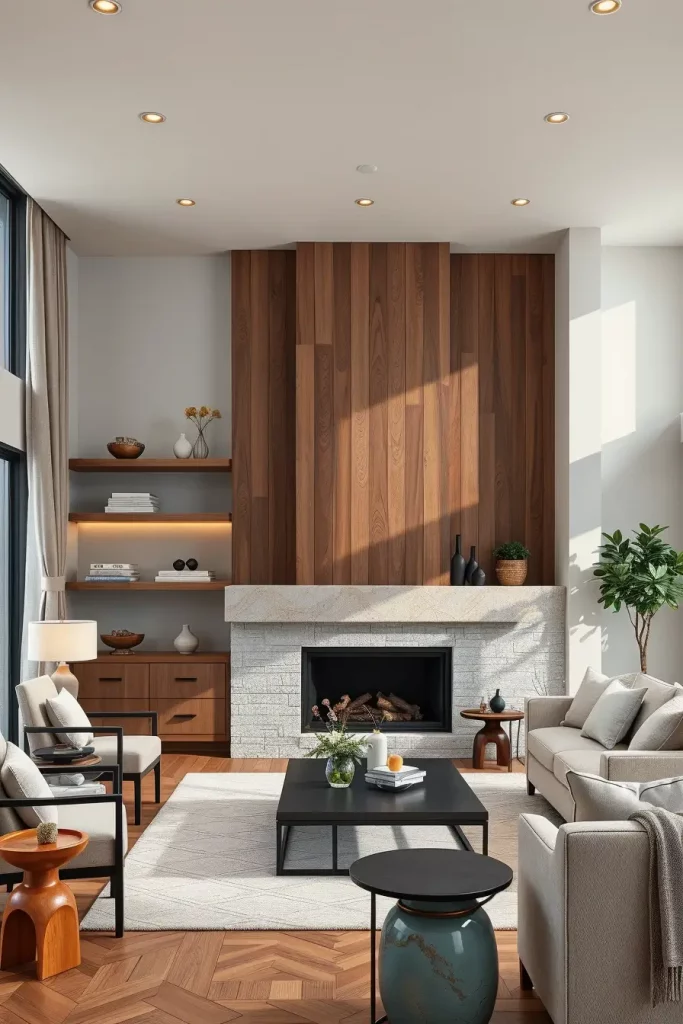
Textured limestone surrounding a fireplace wall and vertical wood slats behind sofas top my list of favorite designs. They are also easily compatible with neutral palettes, offering subtle yet appealing interest. Most often, I include LED uplighting, built-in niches, floating shelves, or servable windows directly above them to further enhance the design’s functionality.
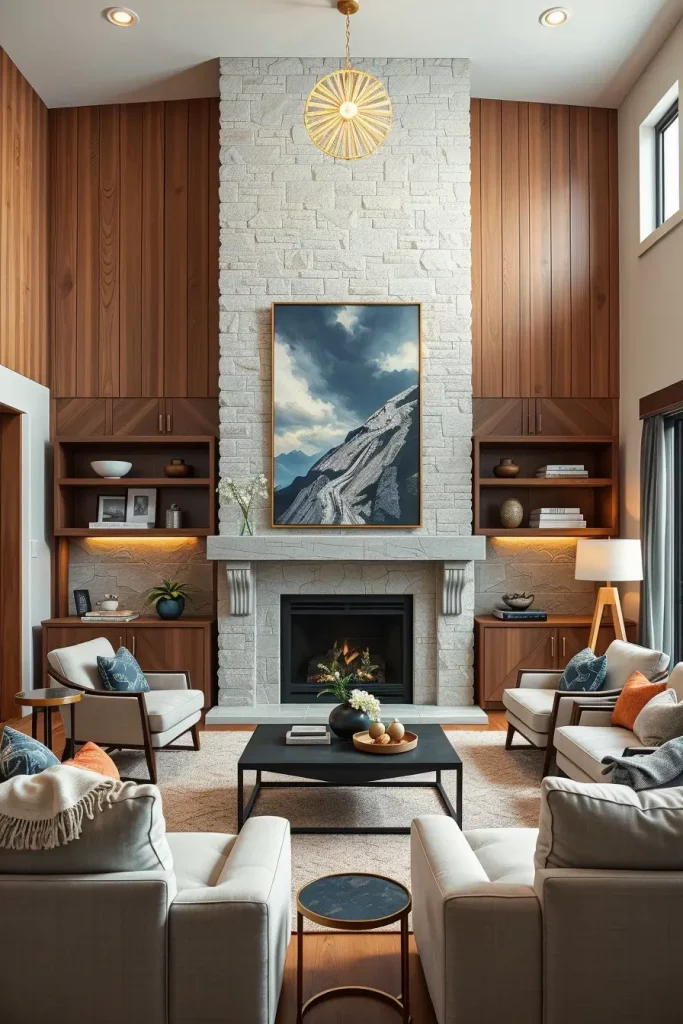
Several designers strategically place feature walls to delineate zones within open-concept spaces in Veranda and Elle Decor. This practical yet elegant approach is something I have adopted into my work.
One enhancement I frequently recommend is embedding art or TV framing into these accent walls which allows even electronics and decor accessories to feel as though they are built-in and curated instead of placed as an afterthought.
Natural Elegance With Oversized Windows
Light is the strongest element of luxury. In any keeping room, oversized windows improve the ambiance and perceived spaciousness dramatically. My preference is full-height or wide-pane casement windows that usher in natural light and are highly visually appealing, allowing the gaze to focus outside. The interior visual congruity complemented by the exterior gives a breathtaking modern and open feel to the room.
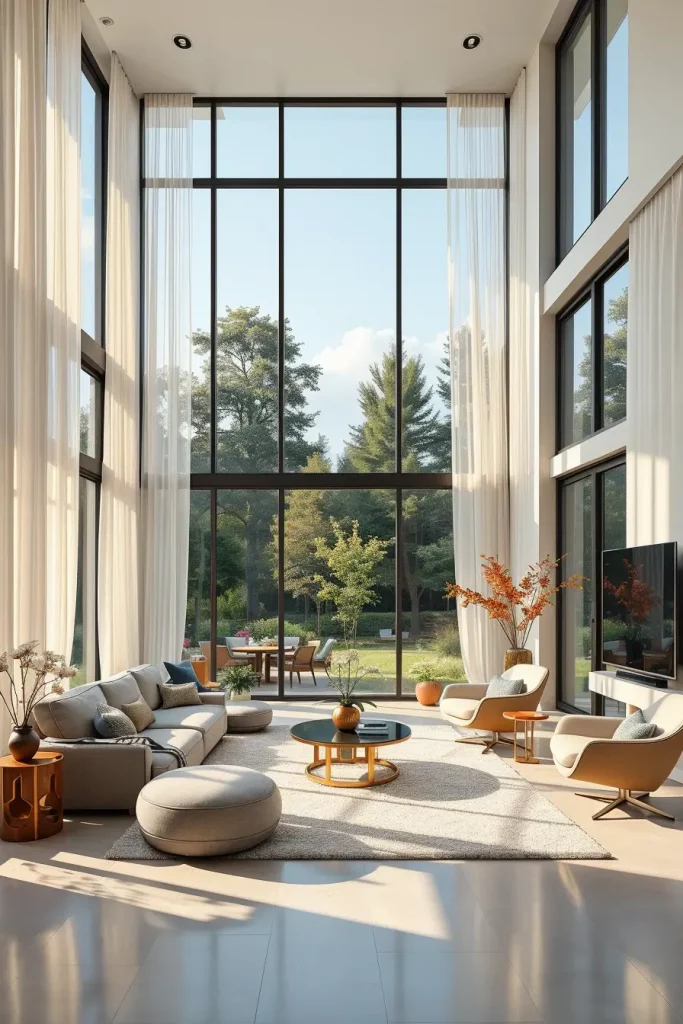
To enhance these windows, I typically go for sheer linen drapes on simple black or brass rods. For added elegance and practical sophistication, roman shades or motorized curtains work wonderfully. Flowing around the view instead of obstructing it makes furniture placement effortless with large windows.
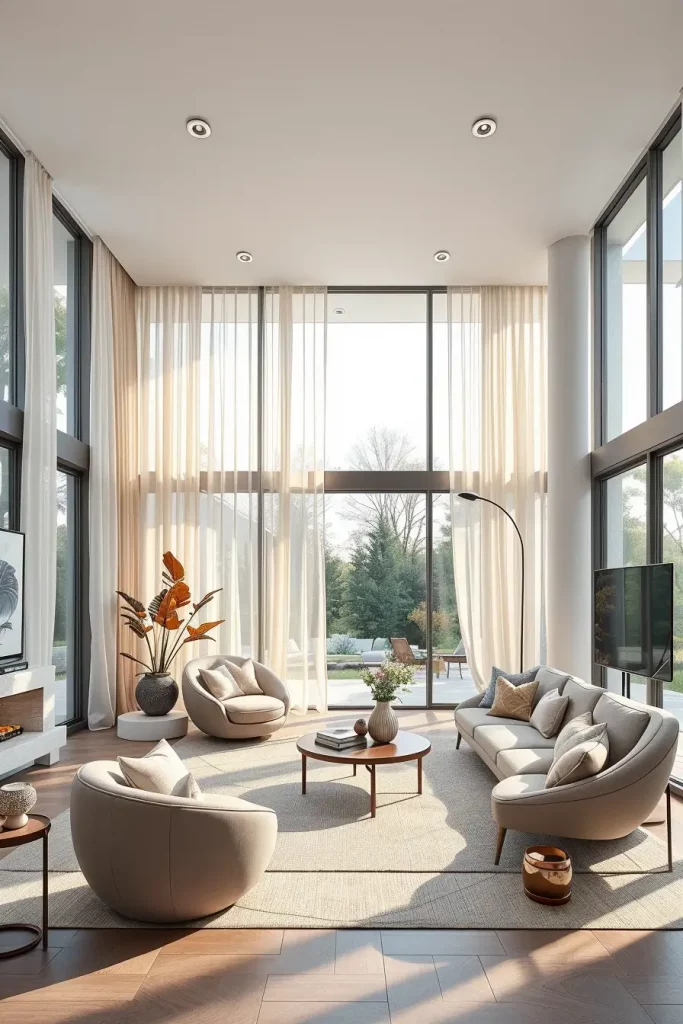
Windows being almost wall-to-wall removes the need for decor, allowing placement and design freedom. The purely architectural aesthetic dresses the room in a curated way observable from every angle. This is why I often show clients examples featured in House Beautiful with keeping rooms designed in this manner.
To achieve that final touch, it may be helpful to customize window trims or add transoms for height and visual interest. These features enhance the architecture while keeping costs low and avoiding expensive construction.
The Role Of Built-In Shelving In Sophisticated Keeping Rooms
Built ins are some of the most impactful features I integrate into keeping room designs. They serve not only seamless storage, but also as a means to achieve visual hierarchy, and as a styling opportunity. From framing a fireplace to spanning an entire wall, built-in shelving creates a sense of balance and completeness within the room.
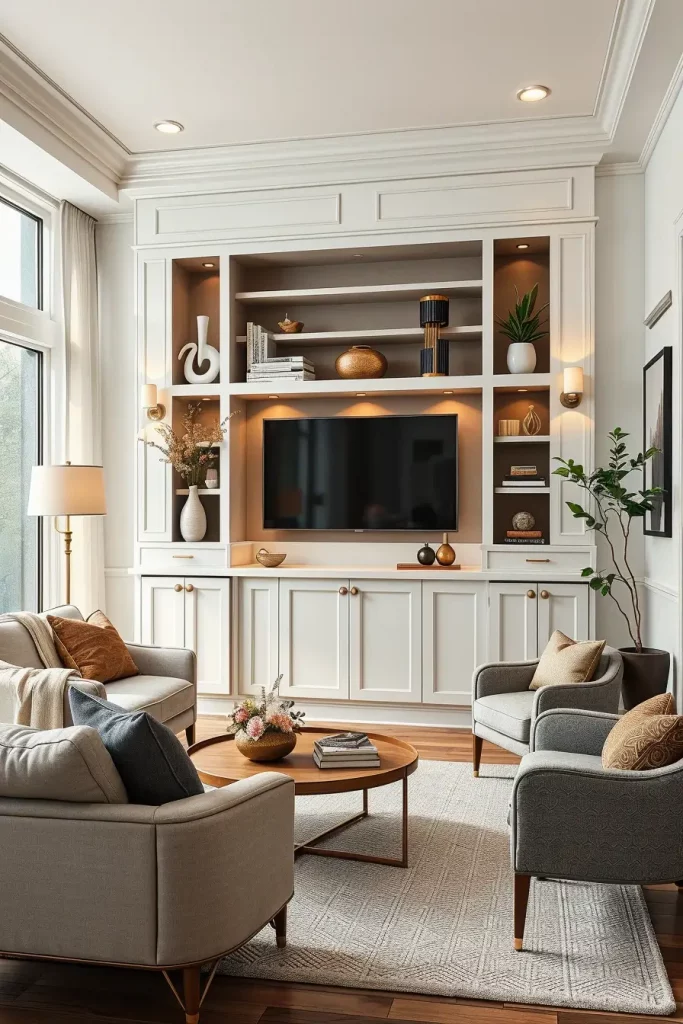
These units create a place to store books, ceramics, vases, and other curated items, allowing the homeowner to display aspects of their personality. These units also eliminate more unsightly clutter. To maintain a tidy appearance, I recommend pairing open shelves with lower closed cabinetry. I often set the shelves’ depth to that of surrounding furnishings to achieve a polished designer look.
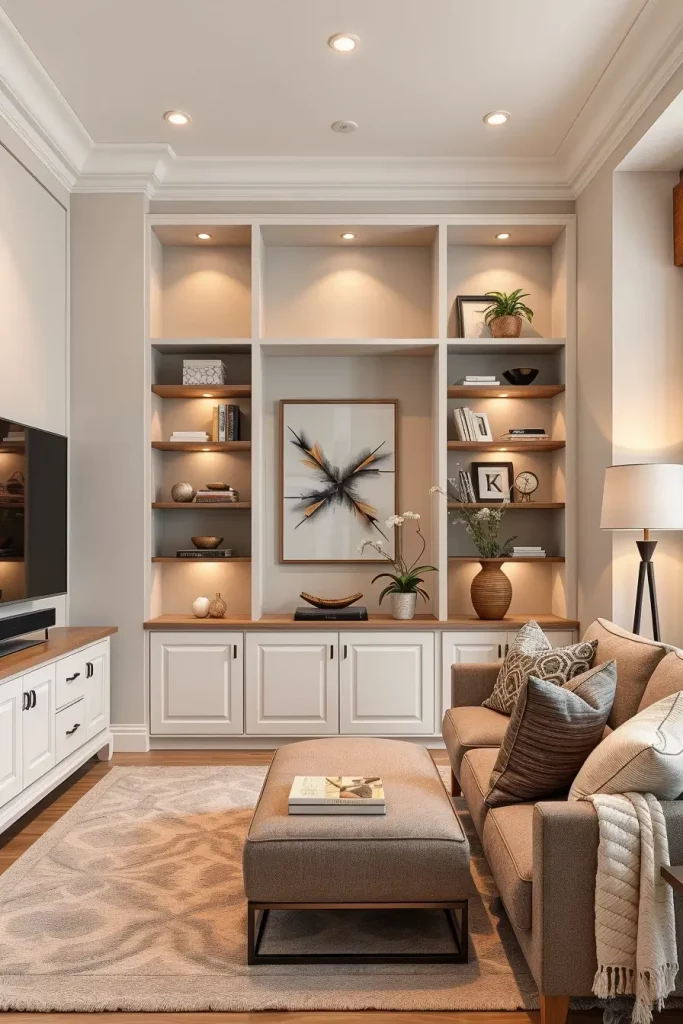
One of my favorite layouts was from a Luxe Interiors feature where the built ins were painted the same color as the wallpaper and the back was done in grasscloth. That layering added a rich organically blended touch to the space while unifying it at the same time.
I’d also think about incorporating hidden wiring or technology into the shelves themselves, especially if the keeping room has a media element. This feature ensures everything is tidy and elegant.
Marble And Quartz Elements For Elevated Style
I always look for ways to add understated opulence to keeping rooms, and one of my favorites is using marble or quartz. Whether it be on fireplace surrounds, coffee tables, or sideboards, these sophisticated materials serve an unmatched level of refinement. The natural veining and smooth texture of these stones contributes towards the modern sophistication and tactile appeal of the room.
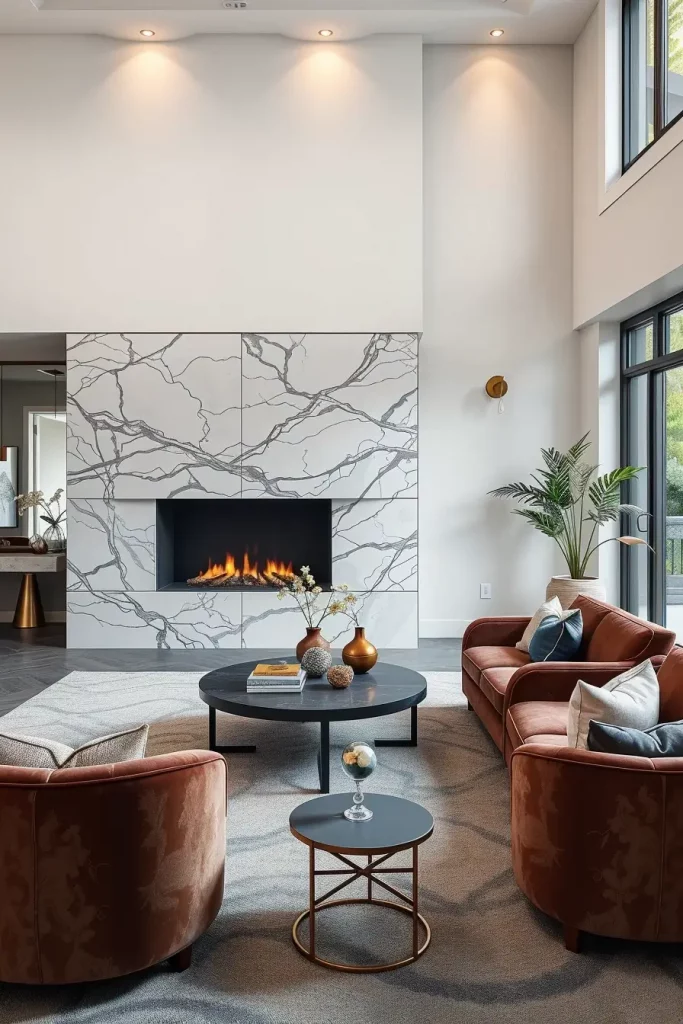
In my designs I like how a bookmatched marble fireplace functions also as art. A quartz topped console, or an oversized marble topped ottoman can also serve as statement pieces. These bolder surfaces tend to be accompanied by softer textiles and warmer matte finishes to create calming balance.
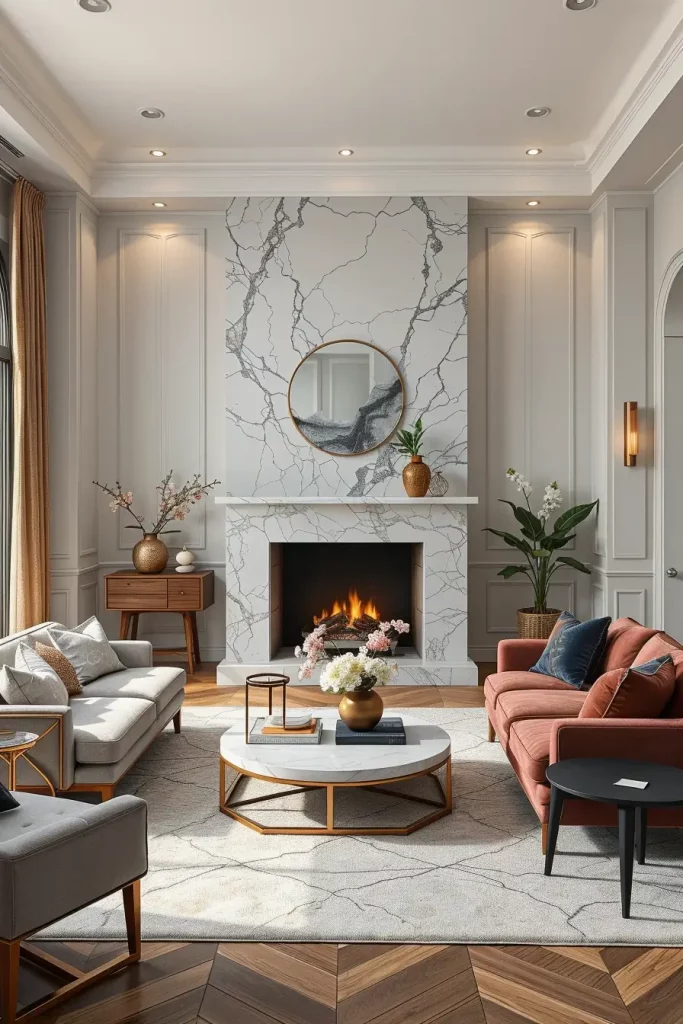
Inspired by Dwell Magazine, which often used marble with great restraint, I find that it’s not about quantity—where one statement piece in marble or quartz would transform the entire space without overpowering it.
If I were to expand this section, I’d look into quartzite window sills or side tables with a honed finish to add beauty and endurance with a unique upgrade.
Statement Rugs To Anchor The Modern Keeping Room
A statement rug is more than just something underfoot. It is the foundation of a great room design. In keeping rooms, rugs define zones, add softness, and create layers that tie all all the elements together. I pick pbgs rugs that completent the calur palette, contrast subtlely with the flooring, and offer both comfort and structure.

Some of my hands favorite picks include hand knotting wool rugs, moroccan style patterns in neutral colors or abstract modern prints with texture and variation. I always size the rug to make sure it extends beyond the fronr legs of all major furniture pieces so the layout feels intentional.
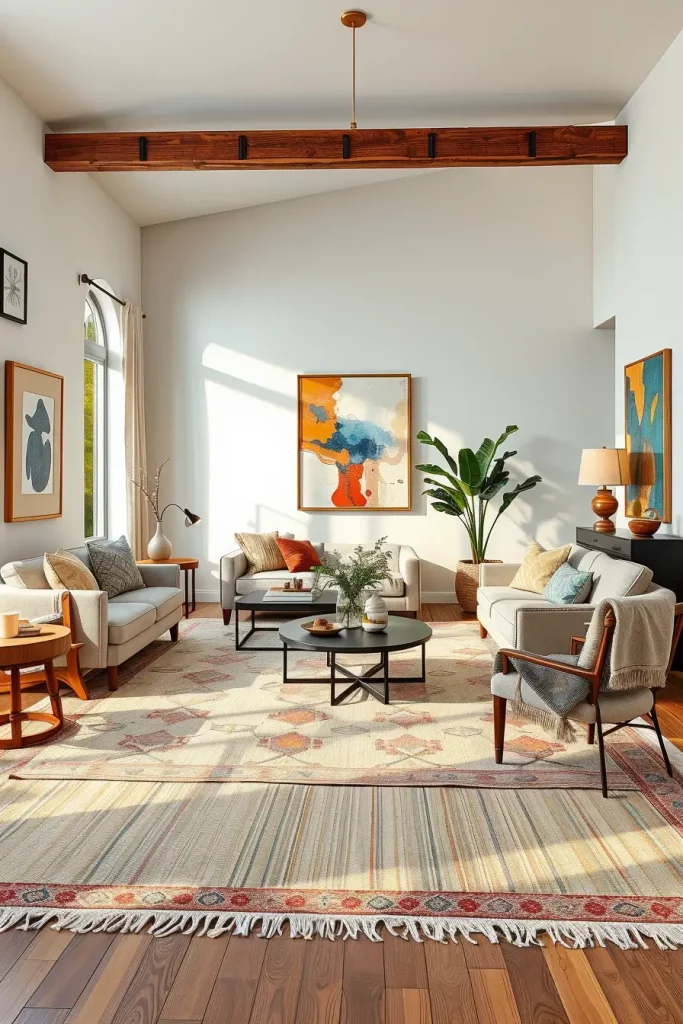
I find HGTV Magazine gives solid guidance here, Choose a rug that makes a quiet statement; something that complements, but does not take over. I really like this tip, this wisdome furthers my style providing pointblanks thoughtful yet refined rooms.
For extra flair, I suggest layering rugs; place a smaller, more decorative rug on top of a larger jute or sisal rug. This adds visual depth, which is most useful in spaces that don’t have strong architectural features.
Decorative Objects and Contemporary Sculptures
In the majority of the keeping rooms I design, I realize contemporary sculptures and other decorative accents do help with an atmosphere. These features contribute to the room in different ways such as to focal points, adding visual appeal, and even adding texture or color in a discreet yet meaningful manner. A keeping room is not just a lounge area; it is a reflection of the homeowner’s character. Designed select pieces like abstract statues and handmade pottery make the space feel elegant and gallery-like, yet balanced so as not to overwhelm the senses.
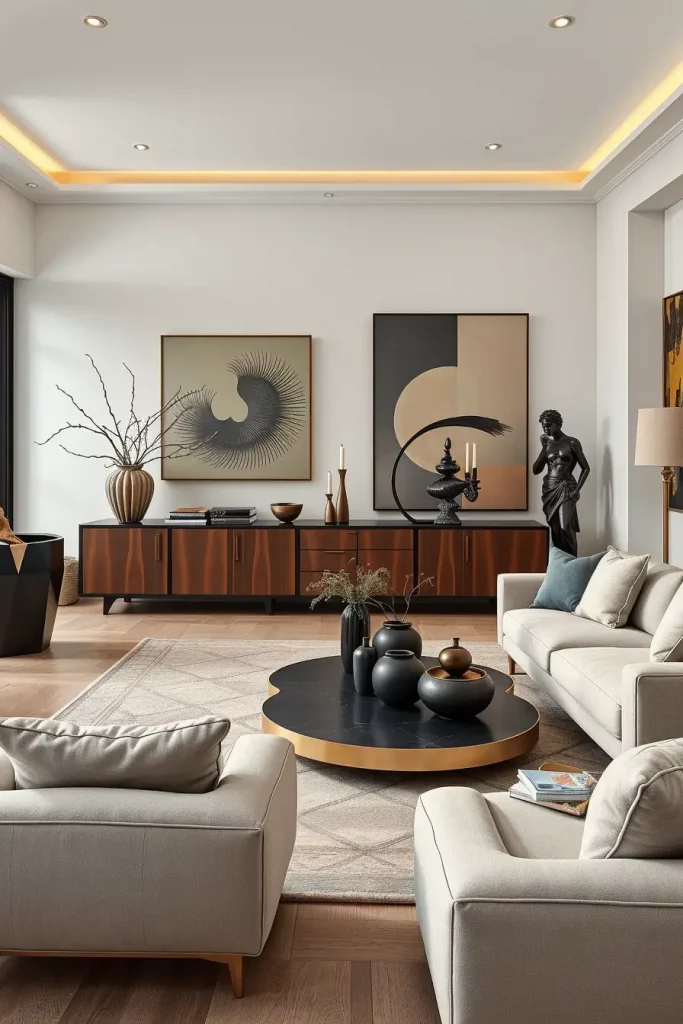
When choosing decor for this styled space, I consider the scale, finish, and placement very carefully. For instance, a sideboard displaying a matte black ceramic sculpture complements the room’s palette, while a brushed brass geometric object atop the coffee table adds sophisticated flair. I often mix natural stone or wood carvings with bold modern elements to create a striking contrast. Each piece should relate to the seating and color scheme, but stand out as a statement design element.
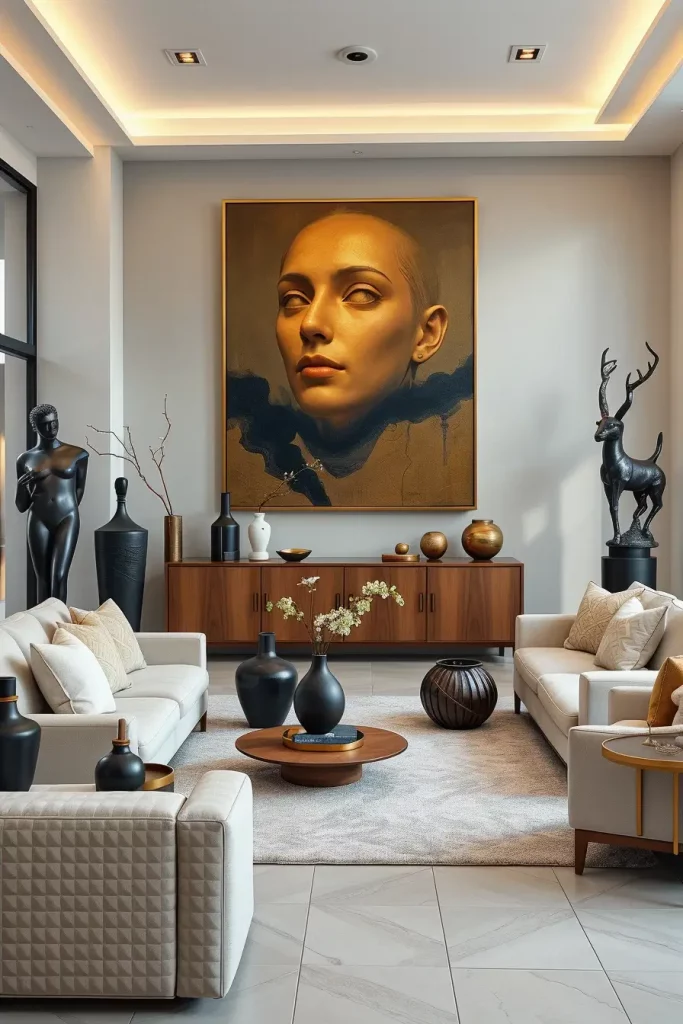
Based on my experience, moderation and cohesion seem to go hand in hand. In my observations, several keeping rooms have devolved into visual clutter due to the overwhelming number of pieces vying for attention. Balance and dimension are so well created by layered architectural structures that are well paired with contemporary sculptures. I agree with Architectural Digest’s previously published trend where sculptural art of neutral colors is perfect for serene open plan living, and it enhances the space significantly. Very true for keeping rooms as well.
In another corner, I would also add a floor-level accent for this section; something like a large scale sculpture or oversized planter would add to the grandeur and vertical dimension of the room.
Transitional Style Keeping Rooms With Timeless Appeal
For keeping rooms that feel modern yet timeless, the transitional style is my number one choice for the client. This style blends contemporary and traditional which provides room for flexibility in design along with longevity. In a transitional style keeping room, there can be structured upholstery along with classic millwork, soft neutrals, and warm textures. No matter the architectural style of the house, this design approach beautifully complements every home.
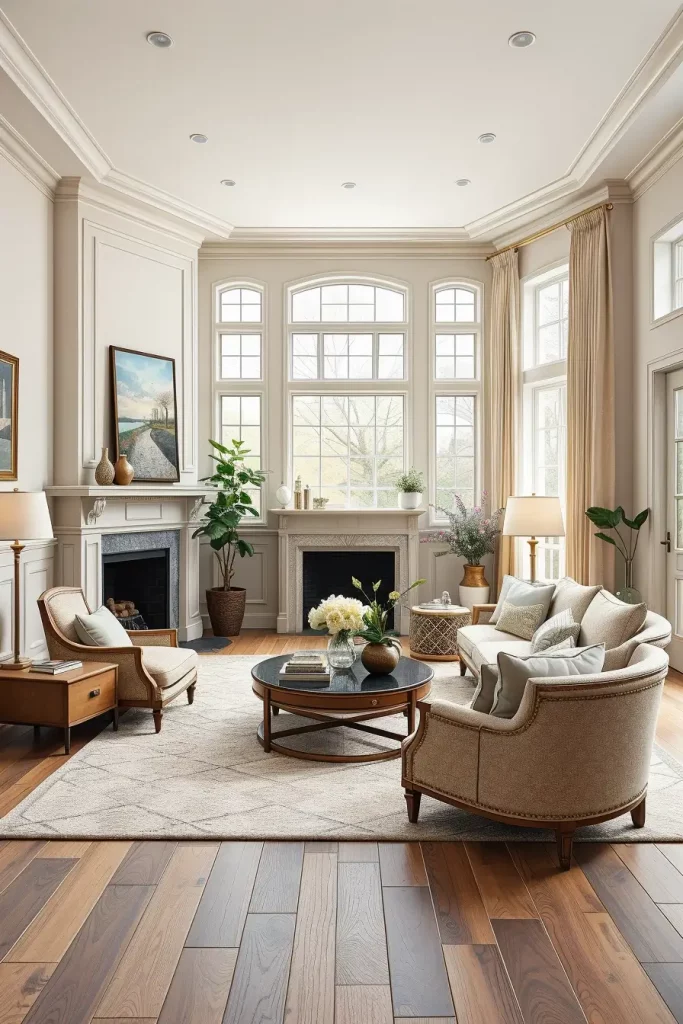
I usually add a streamlined sofa with traditional nailhead upholstery alongside a modern low armchair. The area rugs are neutral-toned with soft geometric designs.Adding color to the pillows brings warmth while accenting the muted color scheme of the room. A white or grey paneled fireplace is often a standout feature. It’s these specific combinations that elegantly but effortlessly blend together—this is what defines the timeless appeal of the transitional keeping room.
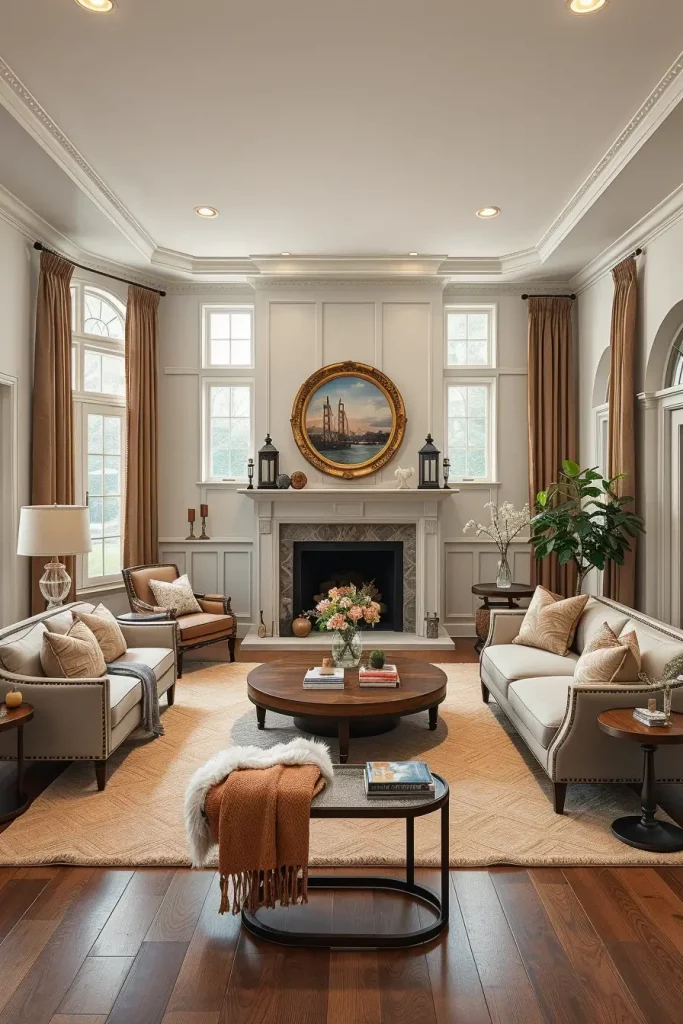
This style, in my experience, works best in homes where different open spaces flow into one another. The transitional design prevents the keeping room from feeling overly designed or too bare. “Transitionally styled rooms are beautifully proportioned,” writes Better Homes & Gardens, and that resonates with my sensibilities—they hit the sweet spot. For those on the fence of being locked and loaded to one design language, the transitional style offers a compromise.
This section would best benefit from the addition of gentle window treatments, such as roman blinds or drapery in linen with natural textiles. This would soften the edges and add a tactile dimension.
Open-Concept Keeping Rooms With Harmonized Design Themes
With open layouts, I try to integrate all keeping rooms into the rhythm of the design story. These rooms often adjoin the kitchen, dining or living areas, so the colors, materials and styles of furnishings need to relate. My first suggestions are usually based on the same exterior elements: unified floor covering such as wide plank white oak alongside warm whites and beiges throughout to ground and connect all areas without overly diluting individuality.
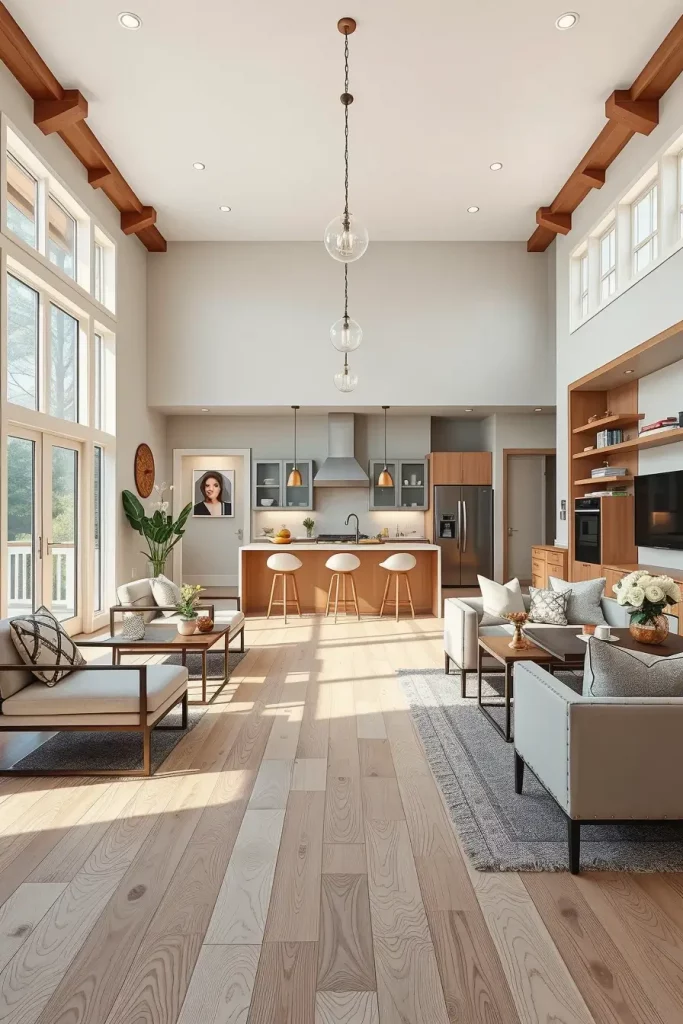
In keeping rooms, I prefer backless upholstered benches to credenzas, since these offer better sightlines and light passage. I also strive for variety of colors and textures by blending materials such as leather with linen and wood with glass for a less homogeneous borders. Everything else depends on the space: a central chandelier or sculptural pendant can tie everything without overloading the space.

From my experience, the best results come when homeowners think about each functional area in an open plan setting as a chapter of a book. They flow lot better visually. Enhanced continuity can be achieved for these seamless transitions between spaces as suported by modern interior design) via unified cabinet hardware or stronger color these touches make the keeping room more cohesive and give it a distinct identity.
Adding a large, soft rug that brings together the color of the kitchen cabinetry and the keeping room seating would be perfect. It visually demarcates the area while adding coziness.
Modern Upholstery Textures For Sophisticated Seating
Enhancing a keeping room can be accomplished with modern sophisticated upholstery textures. My go-tos are performance fabrics for lounging that are chic and stylish. For this space, boucle, velvet, chenille and leather are all great options for casual upholstery.
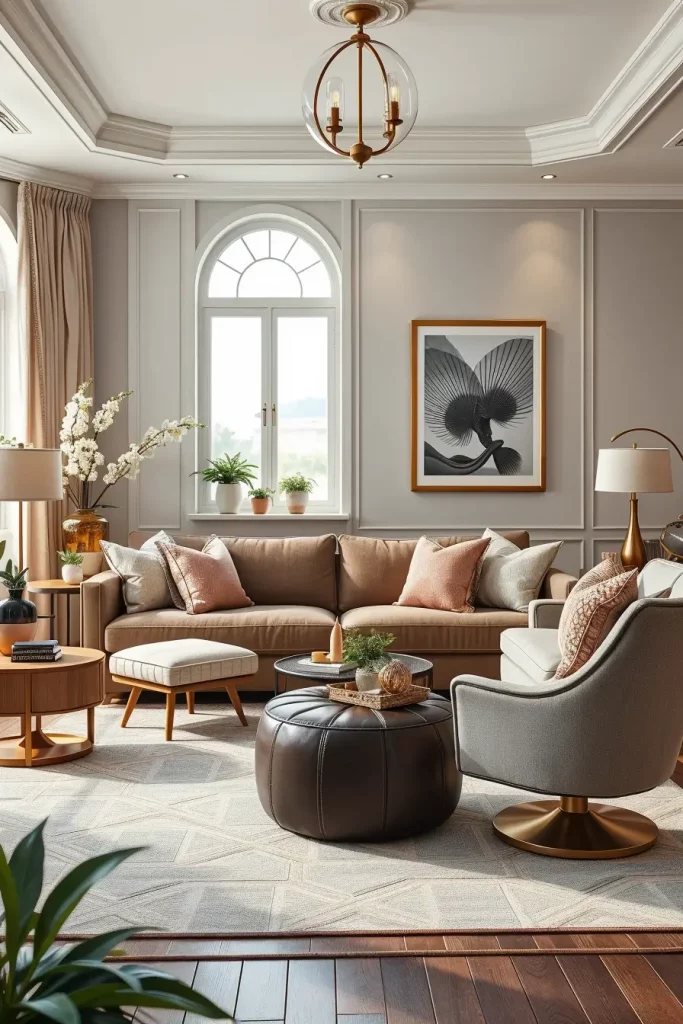
My recommended layout includes a tailored sofa in soft velvet with thin black metal legs along with a boucle swivel chair for contrast. To add functionality, these accent pieces are covered in textured linen or felt and add interesting depth. These materials allow the furniture to stand out without being overly decorative. I also find that high-contrast combinations—like white upholstery and a dark base—are lovely in keeping rooms aiming for a refined look.
For me, upholstery selections express emotions relating to a space. There’s an element of luxury when it comes to velvet, while nubby bouclé is comforting. I remember reading in Veranda Magazine that rooms have to be comfortable to live in, which I believe in as well – keeping spaces offers good visuals and even better tactile sensation.
Another thought I would add to this portion is the suggestion of incorporating popped tufting or piping details to design to add intricate class and flow to the color scheme.
Using Shadow Boxes and Layered Wall Decor to Create Dimension
There is so much more to wall decor in a keeping room than framed prints and generic art. Shadow boxes and layered wall arrangements are my go to for creating depth and visual narratives. ˙In shadow boxes, you may display sculptural objects, textiles or keepsakes of value to you, whereas layered art installations feature various frames of differing styles, sizes, and mediums for a beautifully arranged eclectic display.

In one of my recent undertakings, I placed a set of three large shadow boxes filled with dried florals above the sideboard. Surrounding them were floating shelves with ceramic vessels and family pictures. This type of arrangement offers additional depth and complexity to a space without the need for construction alterations. As for the color scheme, I usually opt for black or deep walnut frames because they provide contrast to the lighter walls.

In my professional opinion, this type of added décor is most effective when it integrates with other features within the space. If the furniture includes warm wood tones, the frames should match those hues. These vignettes should feel more organic than order symmetrically, which I think is great advice for this scenario. Allow the walls to enhance the narrative set by the furniture arrangement.
For emphasis, consider adding LED strips inside the shadow boxes to accentuate the details and provide a soft glow in the room at night.
Symmetrical Arrangements In Furniture Ensures A Balanced Aesthetic
To achieve rest and a sense of unity in a keeping room, I primarily rely on symmetry. It is a traditional design technique that reinforces order and equilibrium in any given space. Whether it is two identical chairs placed opposite a fireplace or twin lamps set on matching side tables, symmetrical arrangements provide clarity and comfort.
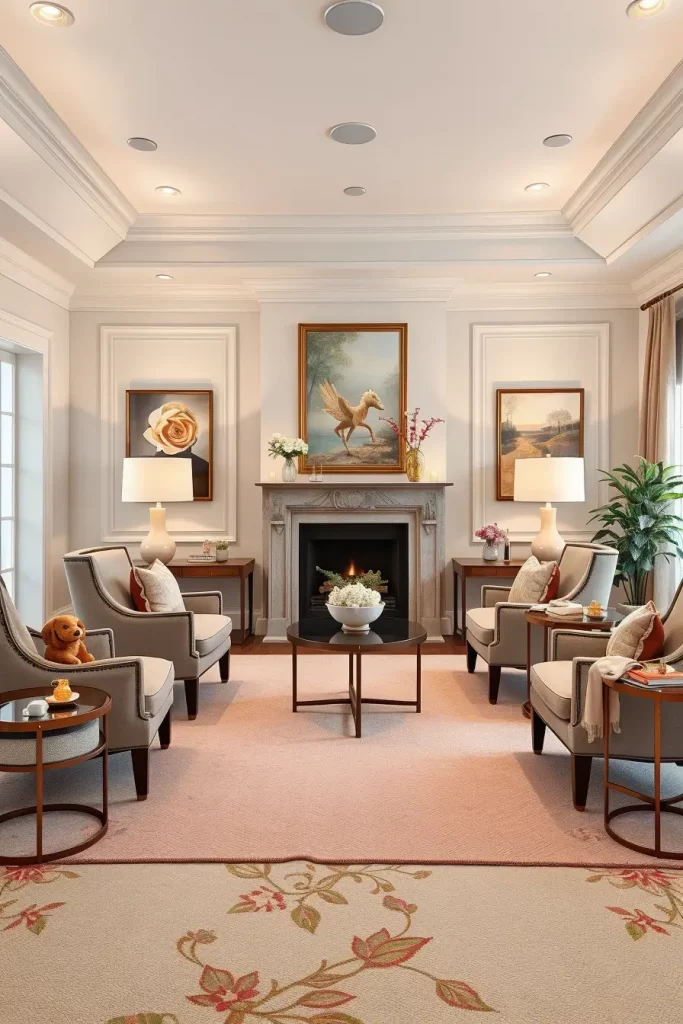
My designs feature every room centered onto a main, often a coffee table or a fireplace. From here, I build outwards. First adding pairs of strong, arms drafts like, matching arm chairs,twin bookshelves, or even identical floor lamps. Grounded patterns, even when the styles differ slightly are placed within arm’s reach of one another, keeping the space anchored. This is highly effective in more formal keeping rooms.
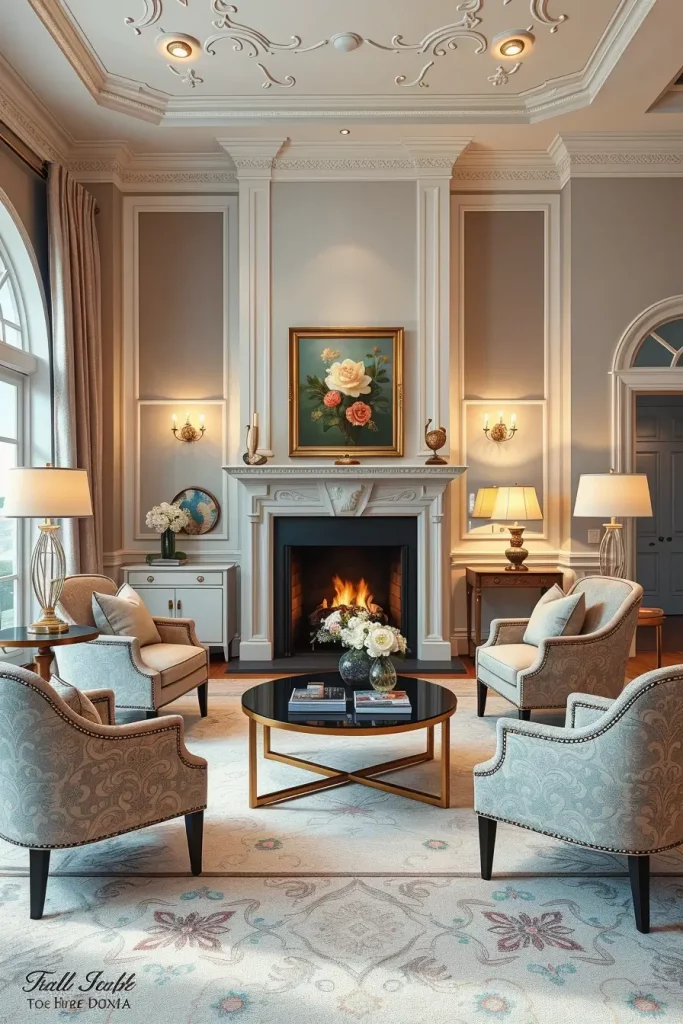
In my perspective, symmetry does not mean the absence of decorative items. It is still possible to combine different materials and textures, but balance in scale and arrangement gives a room a designer touch. Martha Stewart Living recently drew attention on the calm that comes with symmetrical layouts, especially in spaces with too many functions. On the contrary, the keeping room works nicely with this method when it needs to be functional and visually appealing.
Adding suggestions of symmetry to the drapery or wall sconces could amplify this section,” I speculate. These elements alone triple the degree of elegance and balance added to the room.
Designer Coffee Tables As Sculptural Centerpieces
The coffee table in a keeping room serves as more than a mere surface; it is generally the focal point of a room. It is always a good idea to buy something sculptural and useful at the same time. A designer coffee table also serves as an anchor point and weight visually, so it can even add to the depth of conversation.
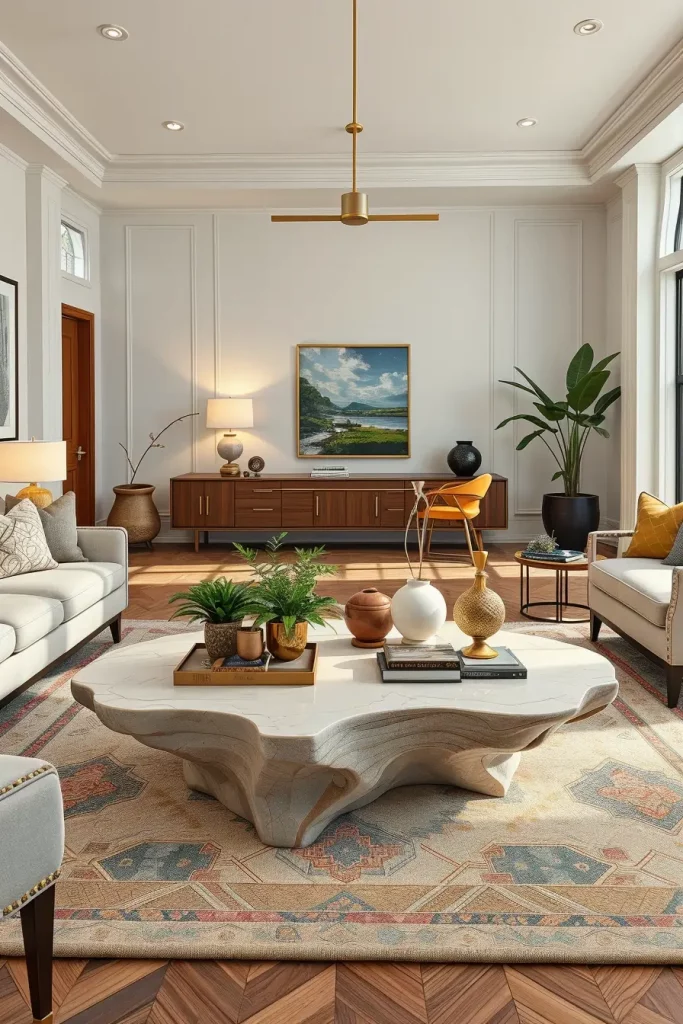
I personally gravitate towards tables that have a more unique silhouette. For instance, the round travertine tops with pedestal bases or the mixed-material ones with glass, wood, and metal amalgamated. Many upscale coffee tables offer clawfoot or compartmentalized storage and featuring trays style pullout drawers, which aids hidden compartments. For styling, I usually start with stack books, a petite sculpture, then add a vase containing seasonal greenery on top to achieve the height.
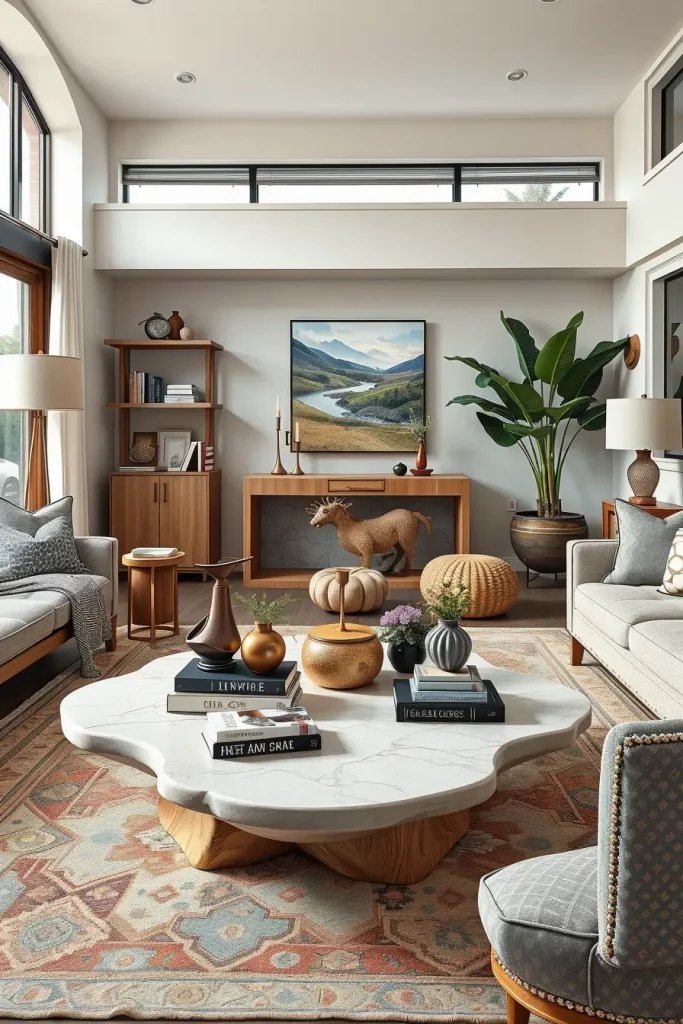
Tables that are sculptural offer a distinctive identity for an area. As cited by dwell, there is a growing trend in furniture designed to double as an art piece, and coffee tables are leading this shift. These tables give the room the desired feeling and creates a look as though it was designed thoughtfully and prepared intently.
In this area, I would add the idea of using the coffee table with a matching rug, round or soft-edged rectangular, to form the central composition outline.
Setting the Atmosphere through Ambient and Layered Lighting
When designing a kept room, one element that stands out and has the most impact is lighting. Warm balanced spaces can easily be created with the use of ambient and layered lighting along with inviting illumination. Functionality is not the only concern; a vibe also has to be considered. General lighting is provided from a central chandelier or pendant while table, floor, and sconces provide accent and task lighting.
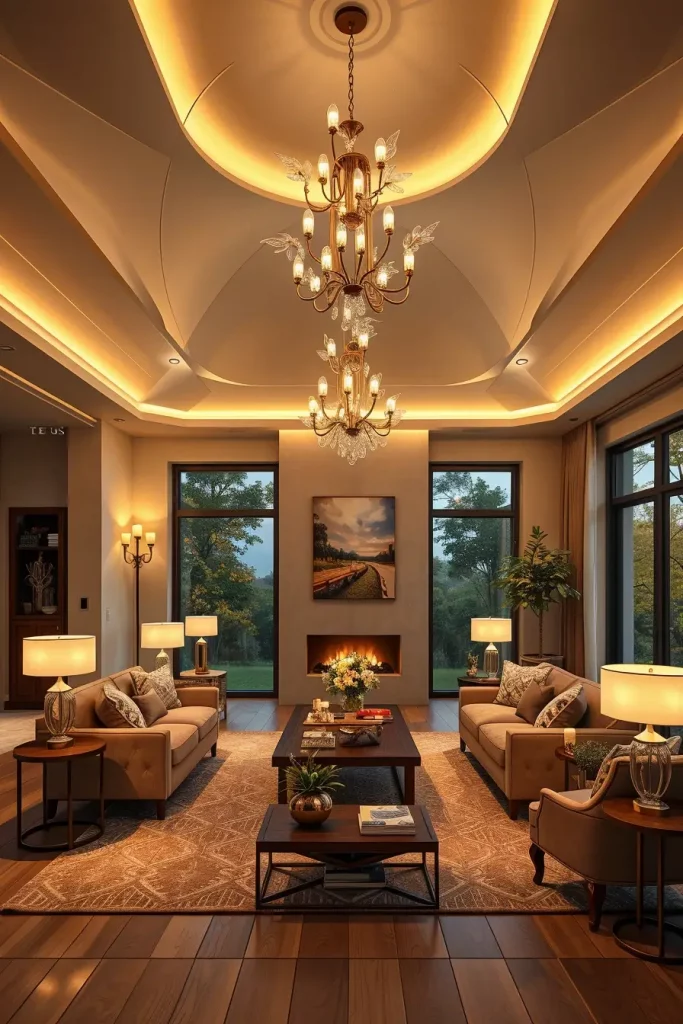
An inspired room is usually commenced with a bold sculptural pendant or statement chandelier. Then, dimmable sconces beside the fireplace or behind the chairs for evening reading can be added. A strong diffusion of light can be accomplished by table lamps with fabric shades. Perhaps accent lighting under shelving or within cabinets to highlight artwork or decorative features can be incorporated. The room achieves a polished yet comfortable atmosphere with this combination.
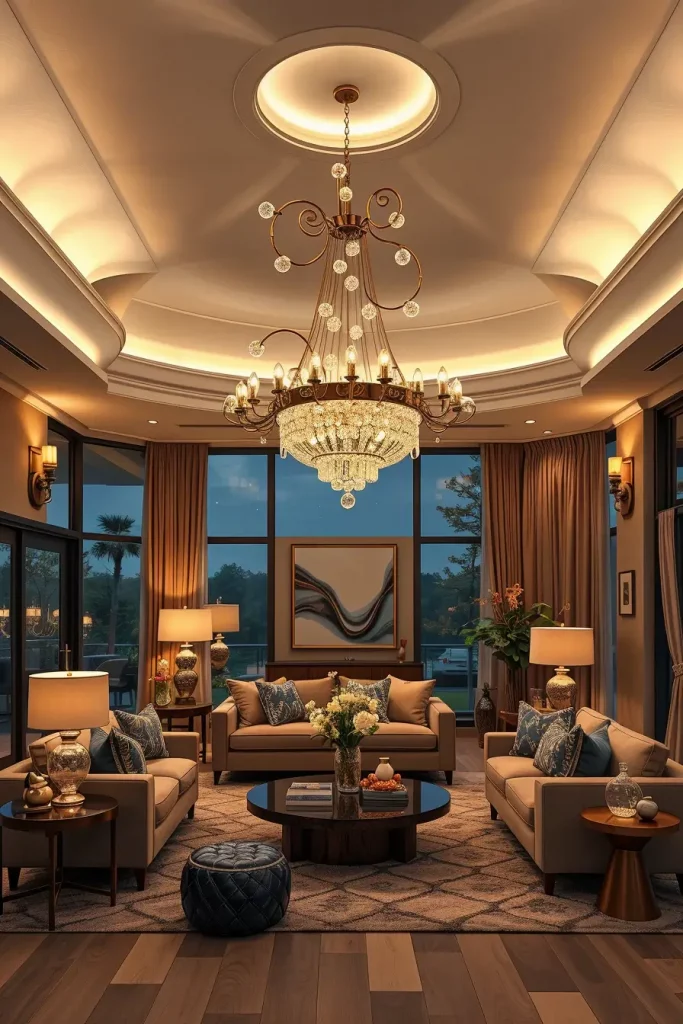
For the comfort of every lit space, precisely as Luxe Interiors + Design notes, layered or circadian-controlled lighting features is one of the most important elements. For that reason I dual layer my window lighting with solar shades and blackouts. Also, for individual control of the atmosphere together with energy usage, in my own home, I use dimmable LEDs exclusively in the keeping room.
To elevate this further I would recommend controlling smart lighting which can be adjusted in different times of the day with specific ranges to cater for all needs.
Styling With Luxurious Drapery And Window Treatments
As a design feature, drapery in a keeping room serves a purpose beyond aesthetics, providing textural privacy as well as acoustical privacy. For prim and proper styled rooms, I always recommend luxury window treatments especially when the room has large glass doors.
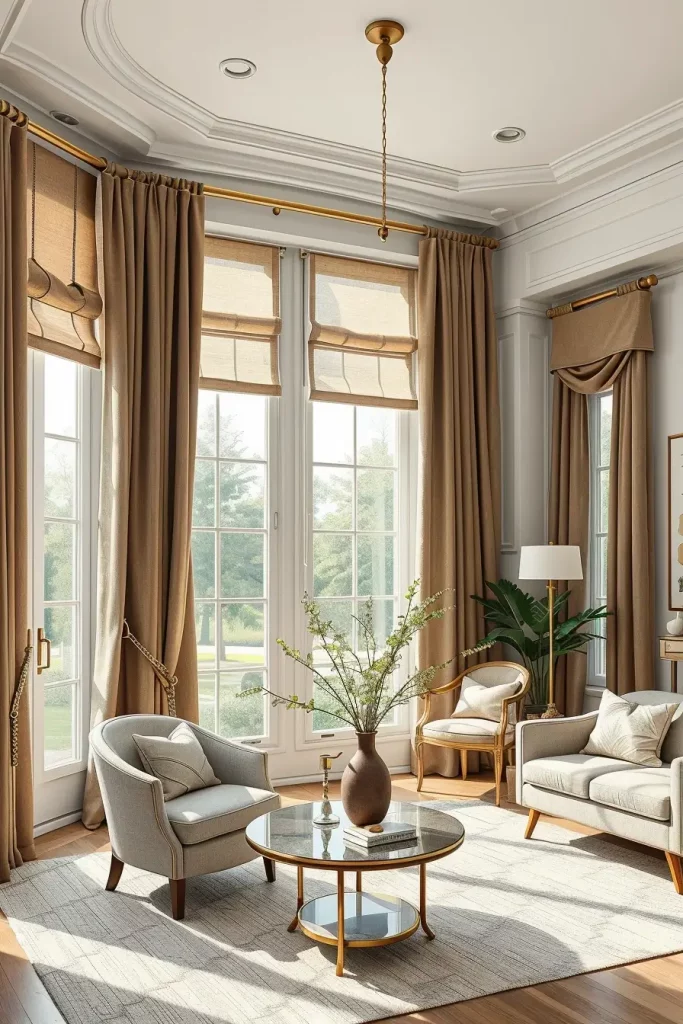
Sophisticated drapery enhances a view and for stark spaces it smooths out the room. It also provides sound dampening when used in high rooms with hard surfaces like ceilings and floors. For a show-stopping effect, I enjoy using floor-length or linen velvet drapery that is usually layered over light-filtering roman shades. Soft taupe and warm white tones always harmonize best, particularly in keeping rooms that tend to be neutral. For a touch of elegance, I prefer custom matte brass or satin black rods because of how they blend with the color scheme of the room. Such small choices in hardware can greatly enhance the room’s cohesiveness.
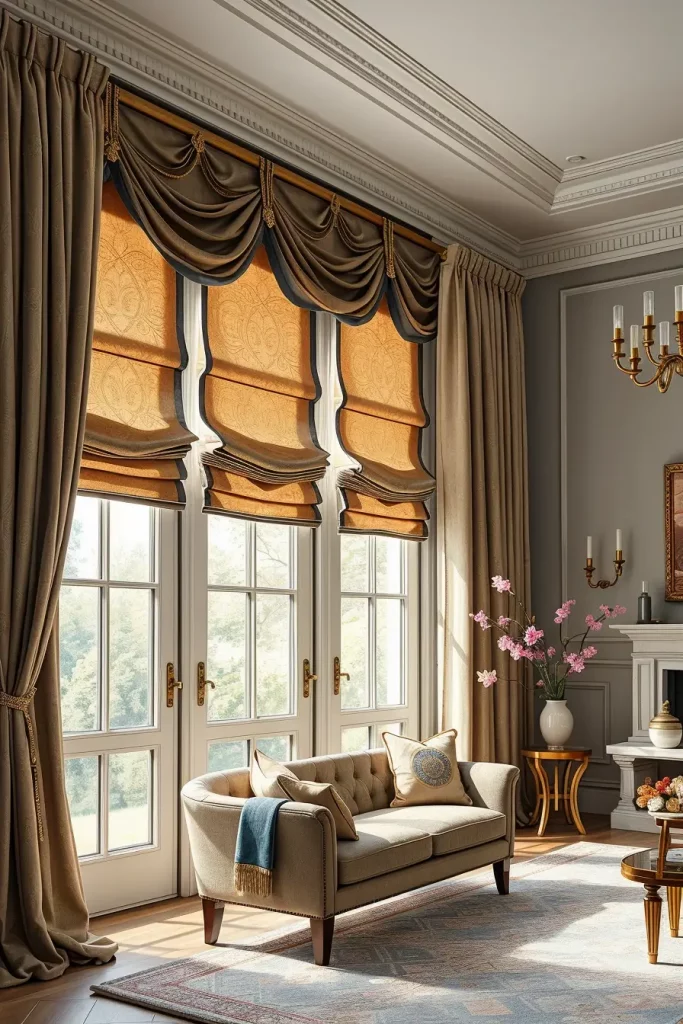
In my opinion, trims are the unsung hero of interior design that singlehandedly elevate the style of the whole room. Keeping rooms with rich layered drapery have been featured multiple times in Traditional Homes and I remember how beautifully they completed the rooms—drapes and all. I like paradoxically think of them as part of the furnishing selection.
To bolster this section, I would recommend decorative trim or fabric tiebacks that add an appropriate texture or color that ties in with the rest of the room.
Sleek Storage Solutions That Blend Form And Function
A keeping room must be both stunning and useful, which is where sleek storage solutions come into play. Be it a lounging area, study, or entertainment room, storage comes in the form of cabinetry, consoles, and hidden compartments. All of which are beautifully designed and preserve elegance. As it is in homes, there is open-concept design which means everything can be seen and storage becomes essential.
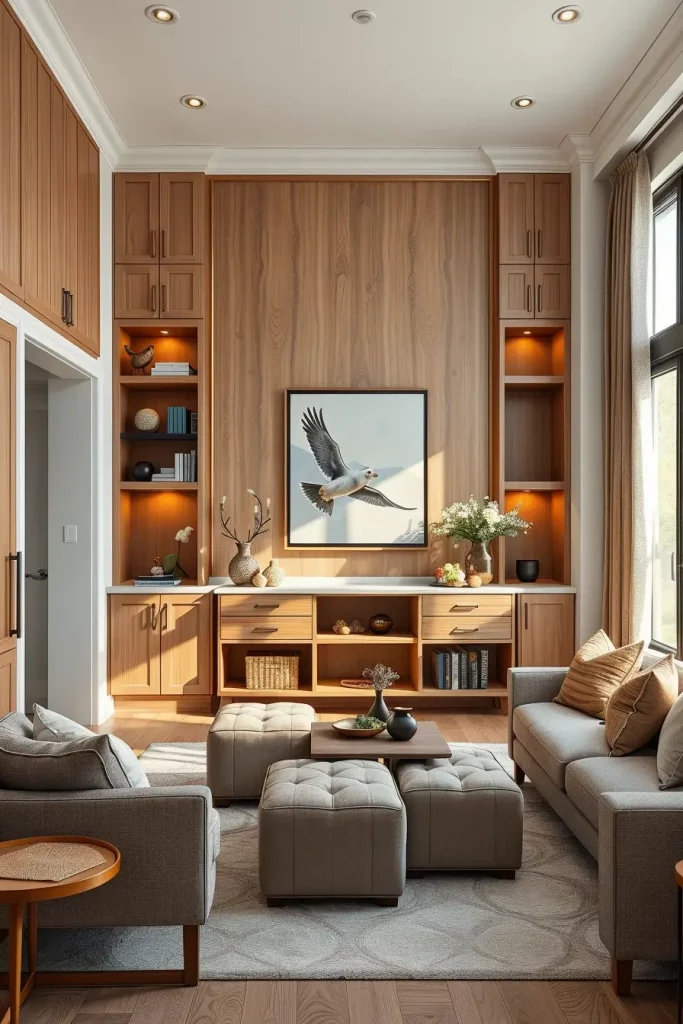
For a more seamless finish, I frequently use custom built-ins painted to match the wall like trim. Everything from low-profile consoles and sideboards with tucked away shelving to ottomans with interior storage are usable. Even stylish baskets placed beneath benches serve dual purposes. With these options, board games, throws, and extra books can be stashed effortlessly. Clean cuts and no frills make these storage options less controlled and more free.

How to maintain a cluttered look is a common question among clients, which is why I focus heavily on storage design. Recently, Domino showcased a collection of open-concept homes which featured integrating media cabinets and floating shelves proving function can coexist with elegance. I especially find this useful in keeping rooms where activities from multiple rooms come together.
To finish this section, I propose including a concealed charging station in a sideboard or an end table to allow access to electronics while keeping them out of sight.
Minimalist Strategy Towards Understated Elegance
I appreciate that practicing minimalist design philosophy in a keeping room brings to life order and calm in a home, especially for busy families. There is calmness and clarity, and it does not mean the space is lacking welcoming warmth. Instead, it focuses on the pleasing features of clean lines, colors, and moderation. Additionally, a minimalist keeping room still has character, yet without the chaotic and cluttered visuals.
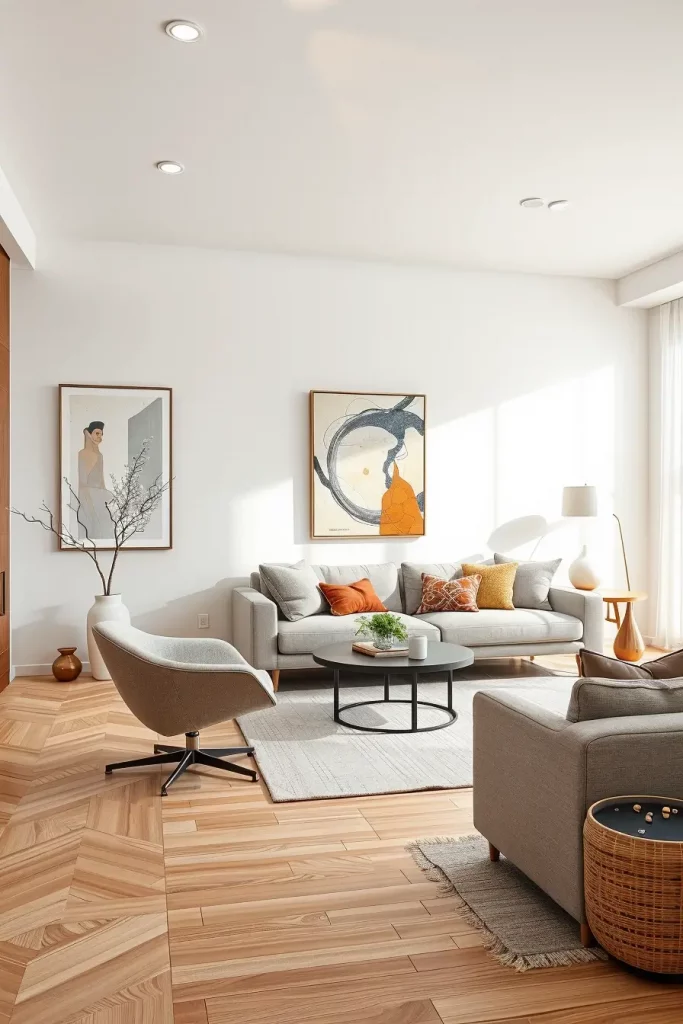
An approach I like to take starts with the foundational pieces: a gently toned low-profile sectional, a sculptural single chair, and one or two carefully selected accessories. I also prefer simple artwork such as an oversized abstract canvas or striking monochrome photography. Items on display are selected and limited to a few with no pattern or floral adornments, as I prefer soft texture like boucle, brushed cotton, or wool and strive to keep surfaces mostly clear.
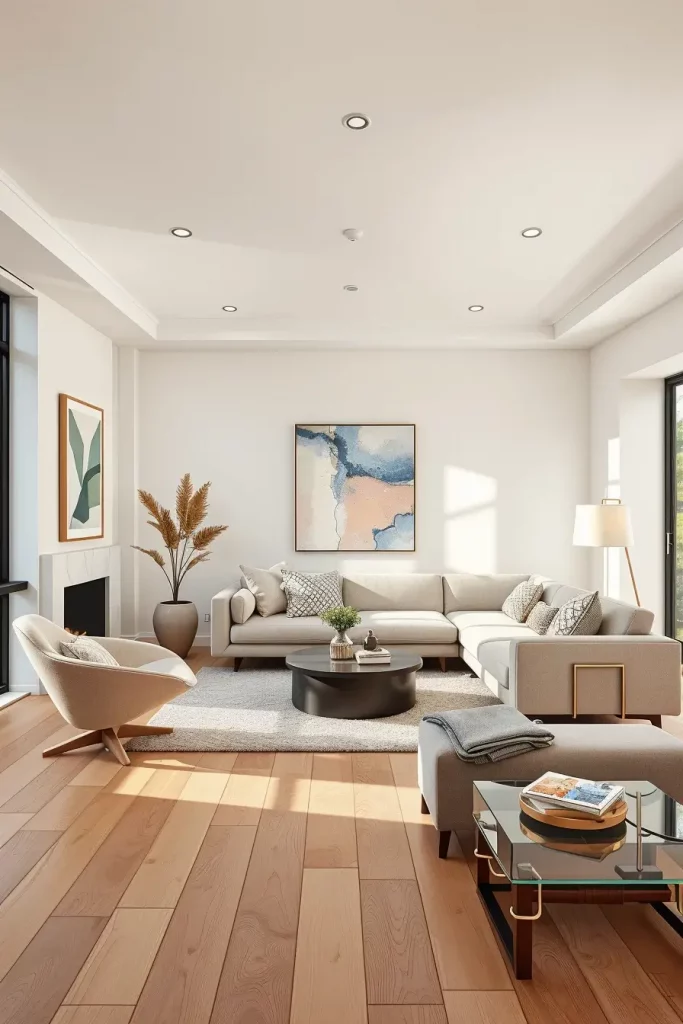
Drawing from experience, this approach enables the keeping room to function as a true retreat. Architectural Digest talked of how minimalism aids in achieving mental clarity within the confines of a room. Additionally, I witness that with my clients time and again. Wherever they go, they seem to be more comfortable in a surrounding where each component has and serves both meaning and prominence.
For aesthetics, I would suggest a sculptural floor lamp and a tonal area rug. Both of which can add definition to the space.
Placing Designer Accent Chairs For A Touch of Functionality And Flair
The importance of chairs within an accent room should be more widely appreciated because they contribute to all practical functions within a living space. The inflow of aides to any keeping room is enhanced by the extra chairs even if one does not notice it. Most point-blank accent chairs do offer additional seating, so it is a matter of whether they shape the room’s layout and express it stylishly. I prefer to select chairs that clash a little with the main sofa; it helps break up the color palette and attract view to diverse areas in the room.
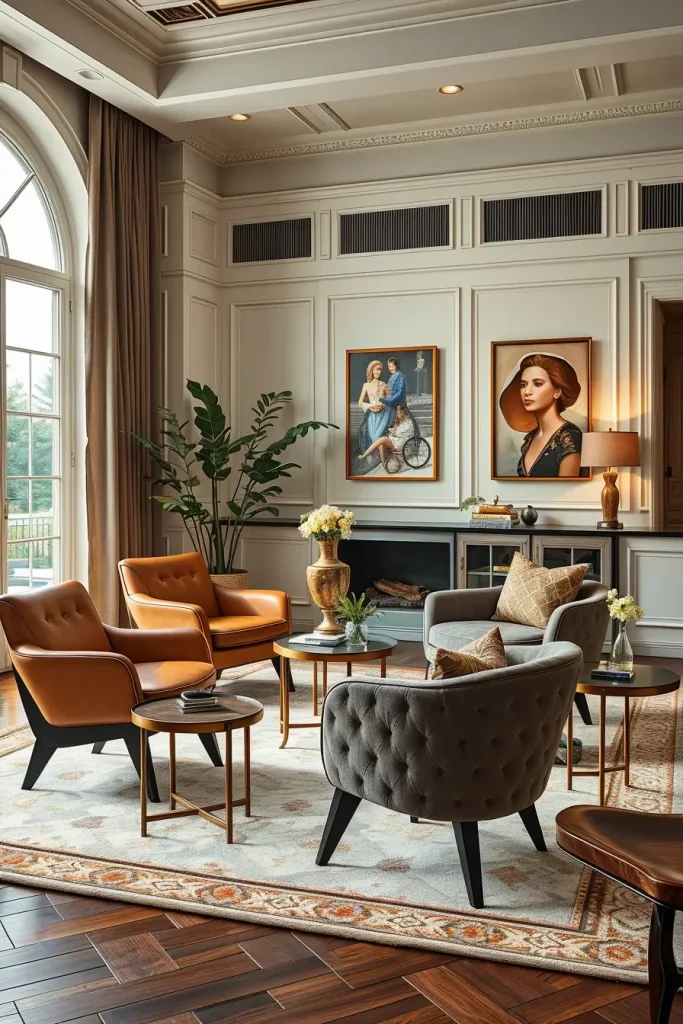
My personal favorites are these rounded sculptural or straight back chairs in warm leather, velvet, or woven fabric because they soften the layout and improve variety. These pieces are perfect for cozy reading corners or flanking the fireplace. For placement leg visibility is crucial therefore I choose pieces with exposed wood or metal legs which avoids heavy visual weight. Further, swivel or armless chairs enhance better conversational flow view with open space planning.
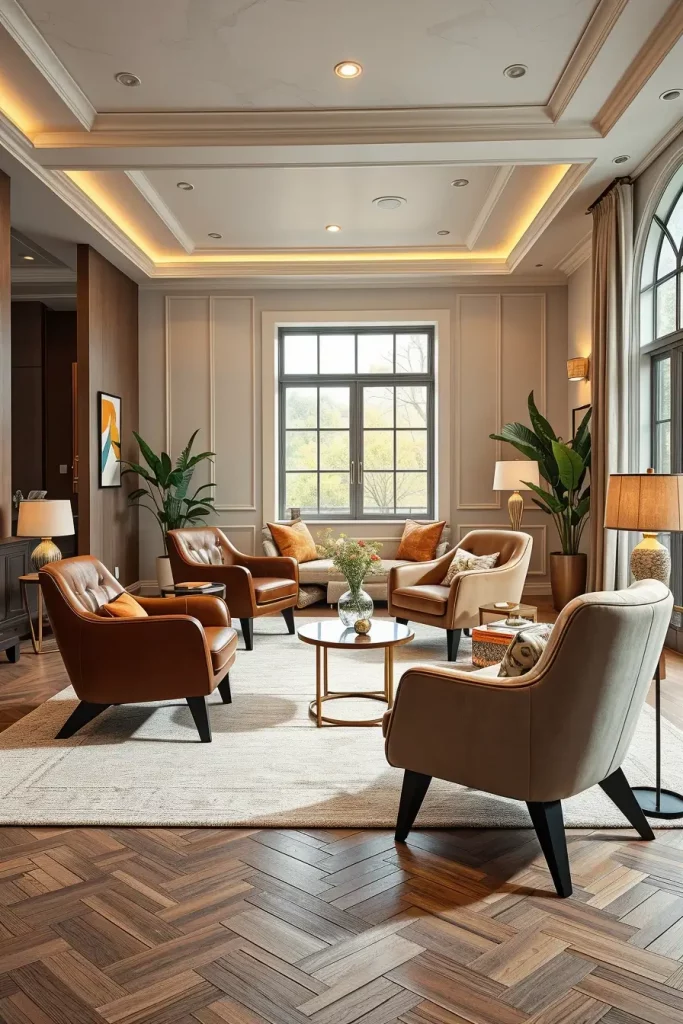
From my experience, splurging on a designer accent chair often becomes a client’s favorite seat in the house. As noted by House & Garden, the iconic lounge chairs do elevate simple interiors, ‘iconic’ indeed, and this holds true in keeping rooms as well. These chairs don’t merely occupy space—they infuse the room with life.
To elaborate further, I would recommend adding a small accent table and a reading lamp to each chair to fully transform it into a personal sanctuary.
Warm Neutral Tones For A Cozy Yet Chic Ambiance
Using neutral tones is a primary building block toward achieving the right balance in a keeping room. It is particularly useful when attempting to strike a balance between warm, inviting, and sophisticated chic. My go-to layered bases tend to revolve around beige, taupe, warm grays, and creamy whites. They reflect light beautifully and work as a calming backdrop during quieter times or when gatherings get loud and energetic.
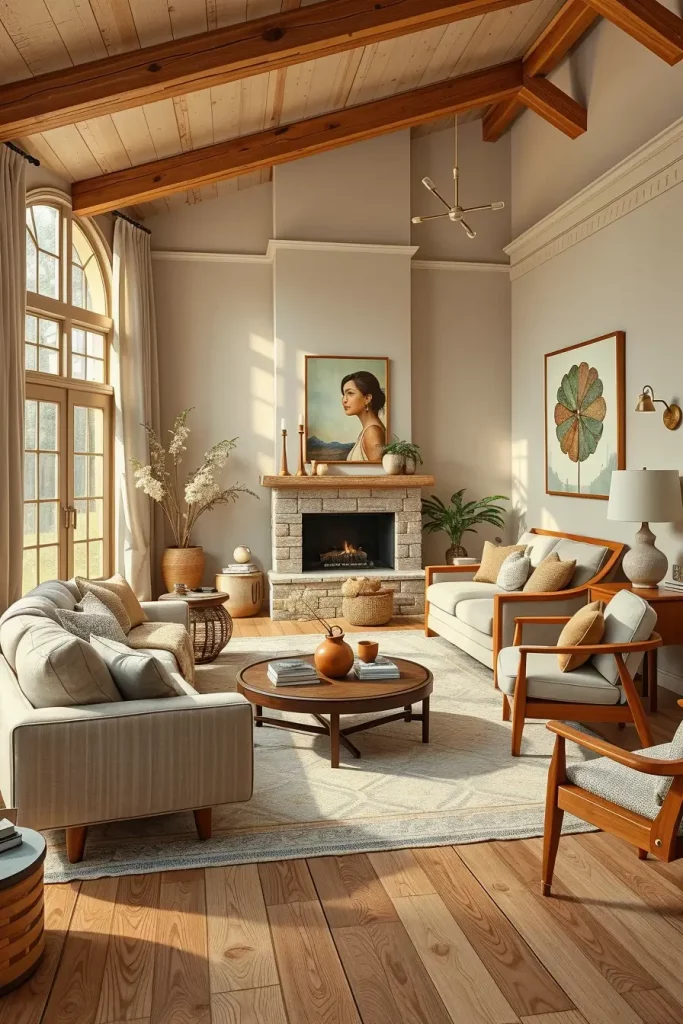
To achieve the required effect, I prefer using a single color and mixing different materials within that color family: a linen sofa, a wool rug, a natural wood table, and stone accessories. That way, interest and depth are achieved without visual clutter. Some other accents like lighting in brass, leather straps on the furniture, or rattan baskets soften the scheme and add color without disrupting the storyline.
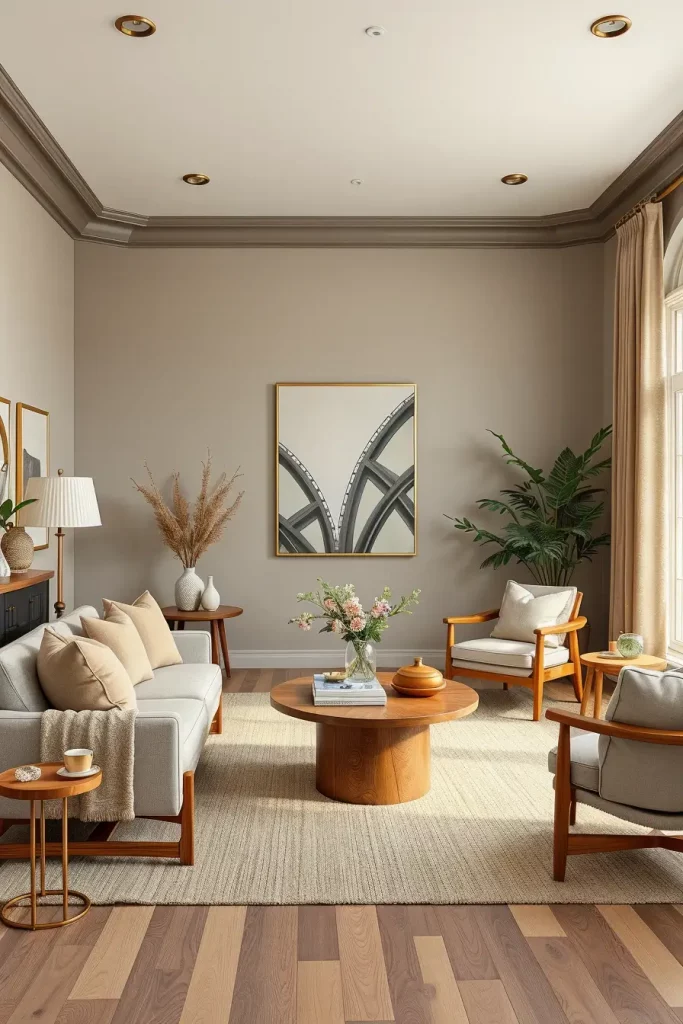
From my perspective, warm neutral colors stand out for their use in summer as well as in winter. Southern Living also points out that they allow spaces in homes to feel more comfortable and personal. In keeping rooms, these colors foster relaxation and cohesion in places that are frequently used.
To not make this space feel overly neutral, I would add a woven wall hanging to bring more textural contrast, in addition to a boucle throw.
Using Greenery In Modern Decorative Planters
Plants breathe life to the space around them; keeping rooms are no different, and installing a plant offers aesthetic value as well as health benefits. I propose a combination of premium quality faux plants and live ones, all housed in designer planters and their mix perfectly suited to the style of the room. One critical aspect is that the planters are just as well considered as the rest of the furnishings.
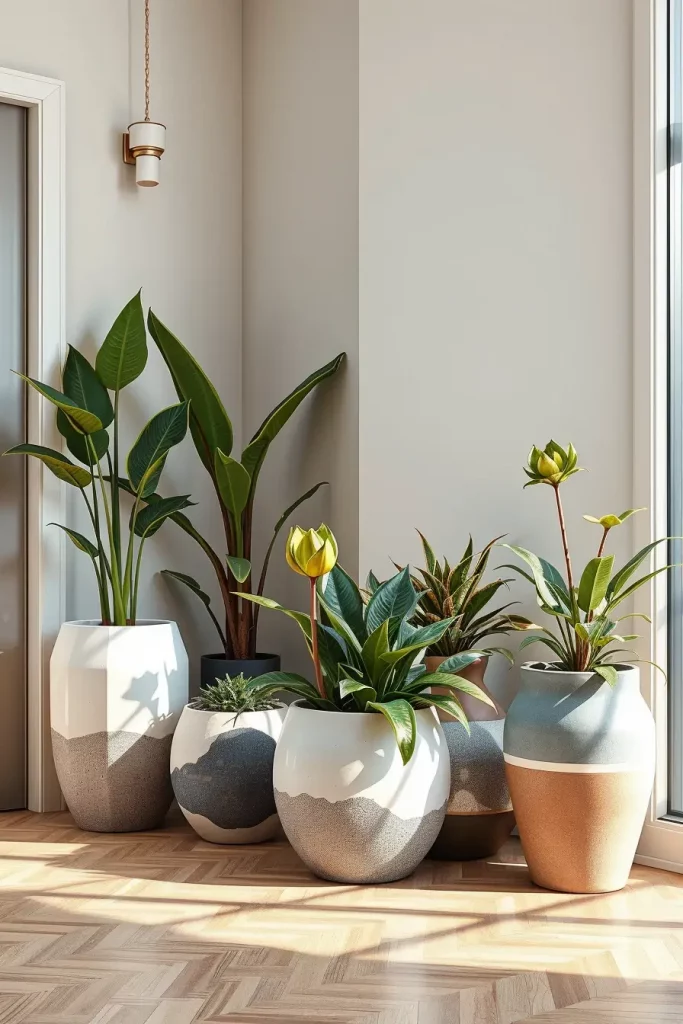
For my designs, I lean towards large pedestal floor planters in matte ceramic, metal, or mottled textured concrete for a more sculptural look. I complement these with smaller tabletop plants in suitable vessels—terracotta, glass, or woven—which I scatter throughout. I steer clear of overly designed plastic containers and instead opt for simple lines in organic materials that offer a blank touch to the overall design.
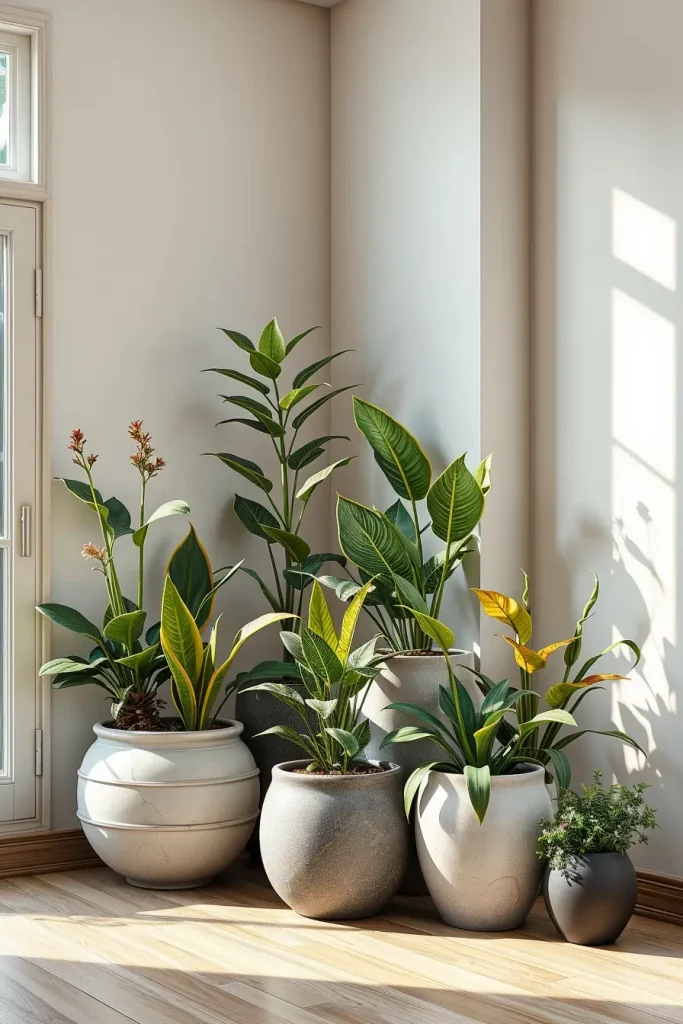
In my personal projects, I appreciate how greenery enhances a space and makes it feel welcoming and fresh. In many teaching episodes, HGTV focuses on incorporating larger indoor plants like fiddle leaf figs or olive trees to make inviting gathering areas. These work great in keeping rooms and help to soften the formality of clean-lined, modern upholstered furniture.
In the macrame planter, I would place a cascading plant such as a modern fern to build a rhythm, while also putting a tall floor plant by the chair to draw a visitors’ eye towards the area.
Artistic Mirrors That Expand And Define The Space
As a designer, a well-placed mirror will always be a reliable tool to create an illusion of space and in a keeping room, it does even more: help the space feel larger while also displaying some curated artistry. For this purpose, I often lean towards oversized or artistically framed mirrors because it adds to the artistry of the room. When positioned correctly, they reflect light so anchor beautiful symmetry within the room. This is especially effective for keeping room designs where the dominant style and color palette is neutral or monochromatic.
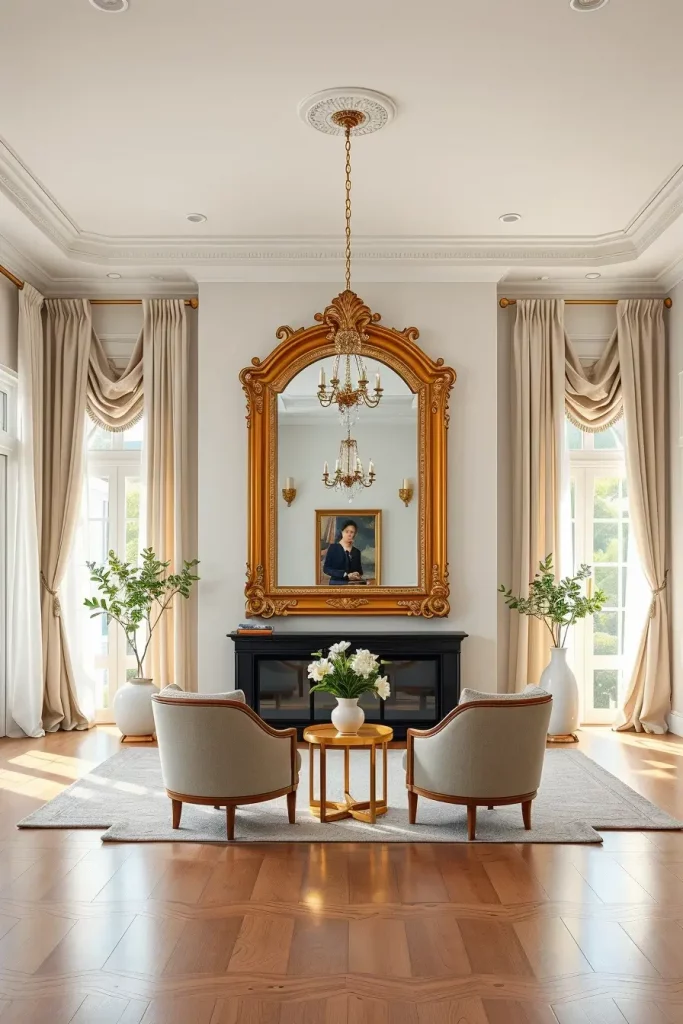
For my projects, I like working with large floor or oval wall mirrors with ornate details or gold leaf trim. They reflect so much more than light, they capture the essence of a space; for example, a warm wooden floor, a linen-upholstered accent chair, and soft drapes. To achieve balance and harmony, I place these opposite to windows and focal points such as fireplaces. A mirror framed with antique or carved wood adds timeless elegance and history to the space.
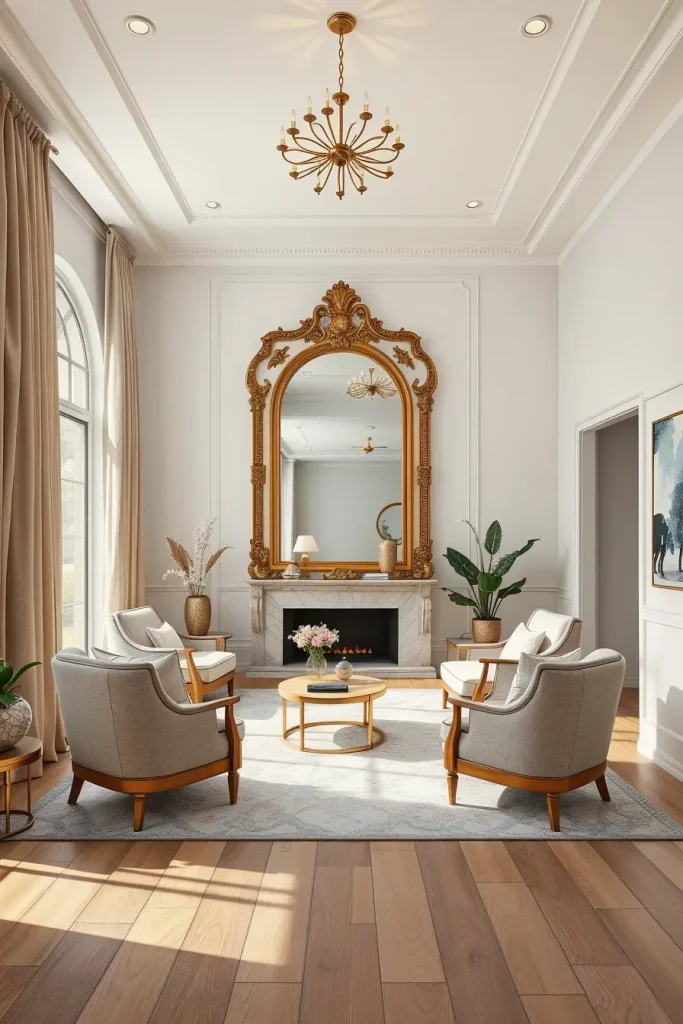
I consider mirrors to be both essential and underrated in design. They add a feeling of spaciousness while also serving as sculptural art. Nate Berkus, an iconic figure in interior design, has said on multiple occasions that mirrors serve great purpose in small and transitional areas. In the words of Architectural Digest, mirrors not only enhance the light but tell the story of the room’s soul. I fully agree.
Softer aspect to add next would be pairing the mirrors with neutral furniture, a cozy area rug, and understated metallic accents that bathe the space in warmth without overpowering it. Strategically placing greenery near the mirror would amplify impact visually.
Sophisticated Layering With Throws And Designer Pillows
In the keeping room, any space can be elevated through layering textiles and soft furnishings, such as throws and pillows. Intentionality is key when using them to elevate warming spaces like the keeping room, in which layering becomes highly inviting. Soft throws and designer pillows can be viewed as the fashion accessories of a room: small yet impactful. In my experience, inviting layering strongly enhances dwell time, allowing for a sense of sophisticated warmth and style.
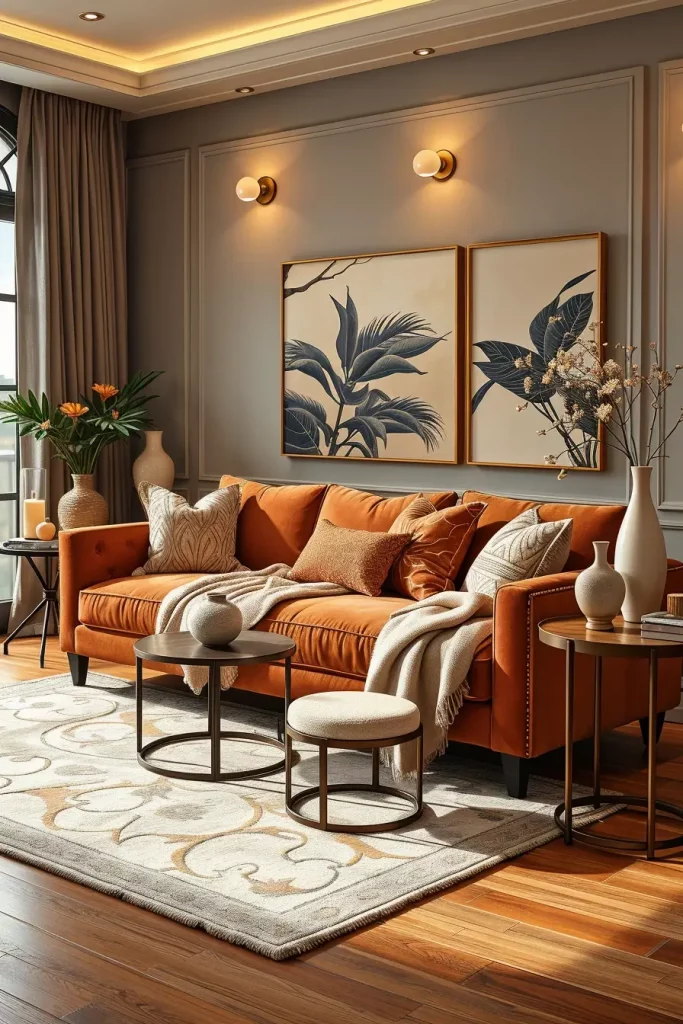
To begin, I like to have a gentle starting point such as a soft colored sofa like a linen or velvet one. Then, I add some cashmere or faux fur throws, folding them or letting them drape down over one side. Adding designer pillows follows next and I have a particular preference for pillows with mixed textures such as boucle, chenille, or silk. My goal is to achieve a color scheme that is decor friendly, which for my style includes earthy neutrals with pops of patterns or metallic accents. By combining square, lumbar, and bolster pillows, I can achieve a tailored and rich multi-dimensional finish to the overall decor.
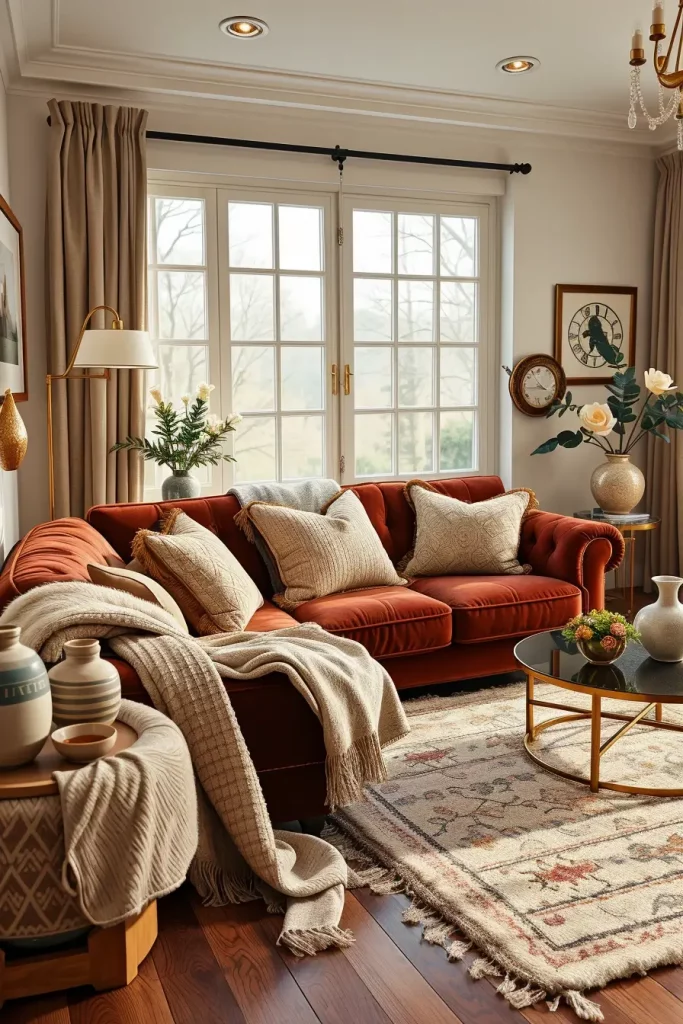
My advice? Ensure the pillows offer comfort both sensorially and visually. They should evoke tactile luxury on every level. Shea McGee of Studio McGee focuses on curated comfort and tactile luxury on every level in her designs. “Layers make a room feel lived in, loved, and designed more strategically,” she says—and that’s the effect I hope to achieve.
This area could be enhanced further by adding coordinating details such as quieter illumination from lanterns, ceramic vases and a woven bench at the foot of the seat that all work in conjunction to evoke a welcoming feel.
Custom Decor Like Monogrammed Details or Personal Diagrams
Nothing integrates more beautiful elements in a keeping room than the addition of personal touches. Touches such as custom artwork or even pillows with monogrammed designs capture the identity of the homeowner. It is my experience that areas designed around personal stories add a touch of emotion alongside the visual beauty. Initials, family crests, or custom signs fused into the decor to personalize it often elate clients.
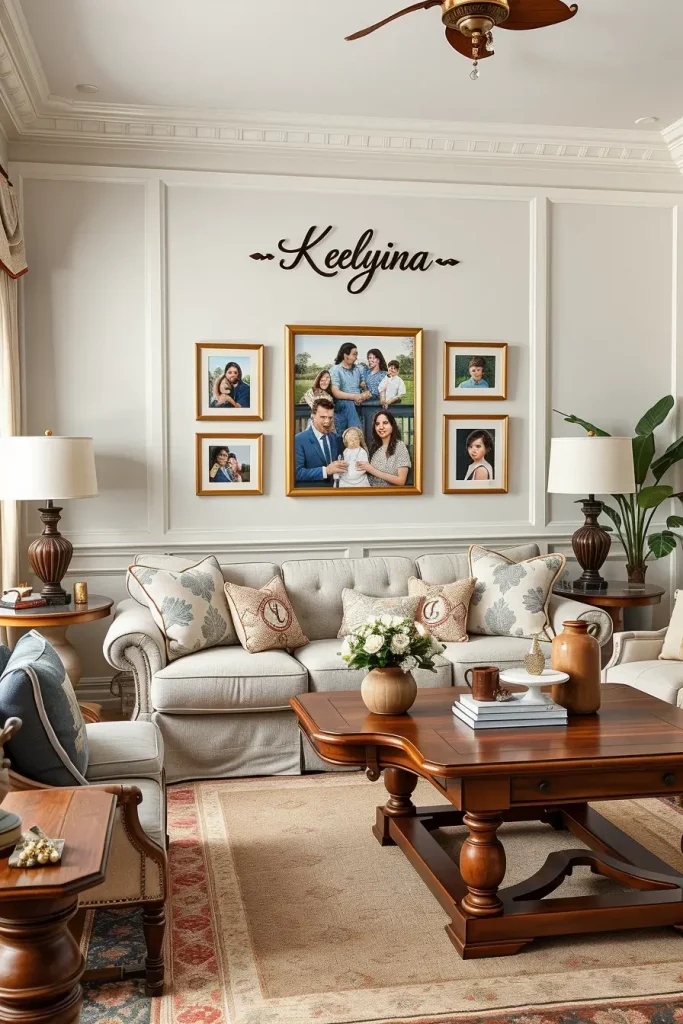
For this style, I incorporate embroidered pillows and window treatments with monogrammed linens. The stitching is often done with the embroidery thread of a contrasting color. Other intimate touches include framed family photos, handcrafted name plaques, and quotes written on canvas. The customization extends to a side table or bookshelf with engraved initials that makes bespoke the rest of the room. The focus should be on a balance—targeting one or two such items aids preventing the room from transforming into a showroom.
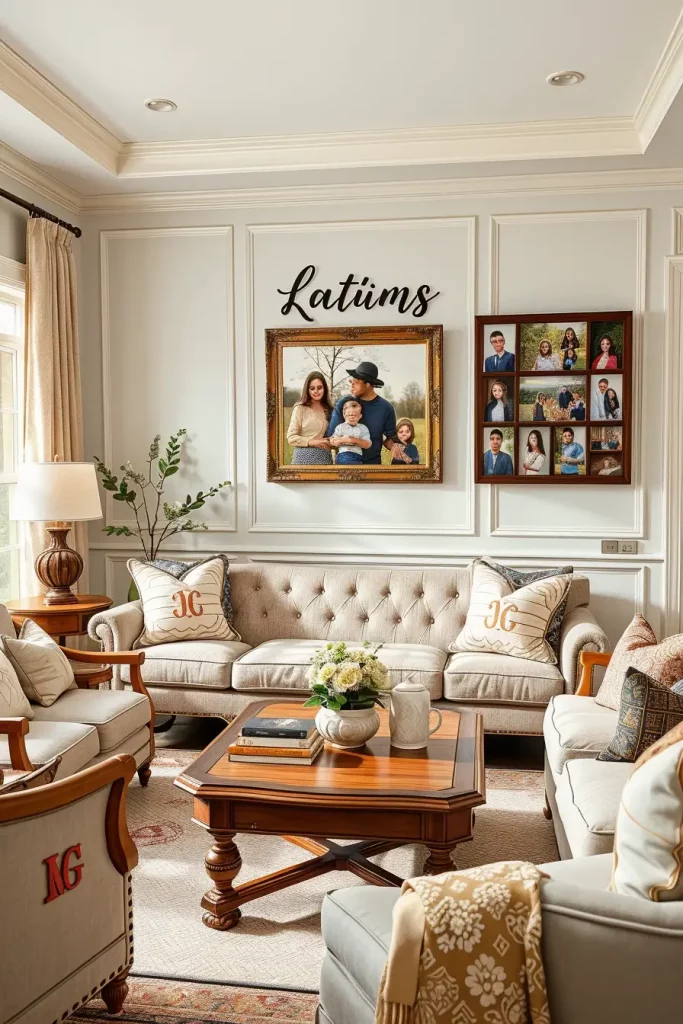
These additions provide a sense of complementing identity. It reminds me of a couple I worked with that commissioned a custom painting of their wedding venue—the piece encapsulated the essence of their keeping room. House Beautiful cites “the most memorable rooms are the ones that feel personal.” I cannot agree more. Personal touches aid define identity and invoke comfort in a room.
To better round off this concept, I may also recommend incorporating a gallery wall or a niche setting for displaying cherished family heirlooms. This achieves the goal of thematizing the personalized components without cluttering the design.
Seasonal Styling For Ever-Evolving Designer Keeping Rooms
I’m captivated by seasonal styling because of the way it breathes life into a keeping room throughout the year. Achieving this is possible by introducing new colors, textures, and other details at different times of the year while preserving the essence of the room. This approach works well for clients who like change but not an overhaul. It is creative, flexible, and inexpensive.
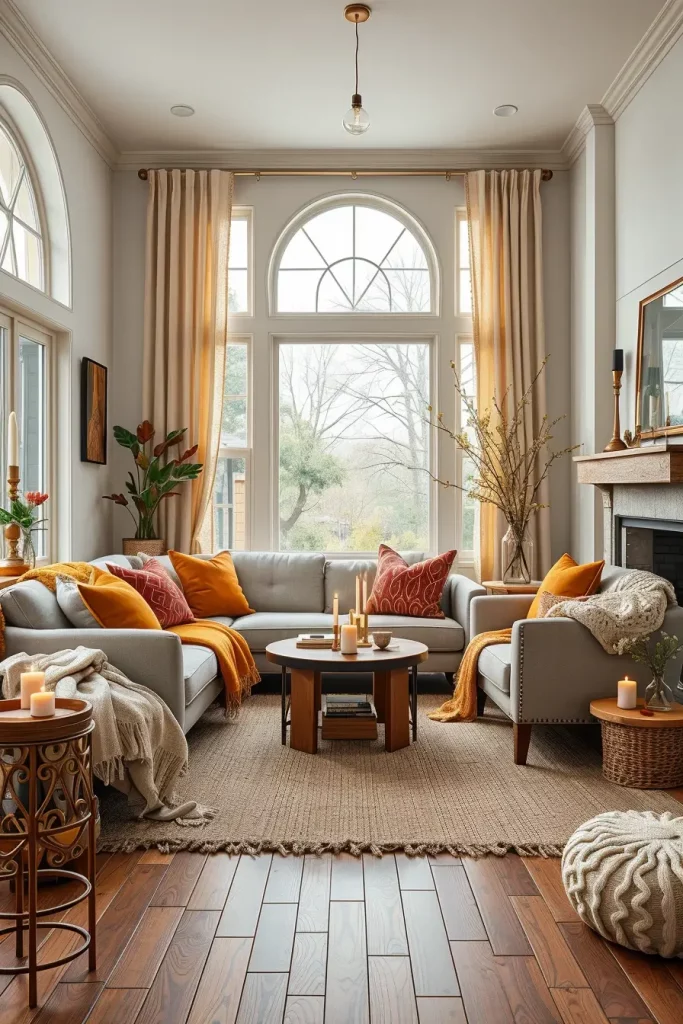
Every season offers a fresh opportunity. In fall for example, I’ll introduce wool throws in rust or mustard paired with plaid or cable knit accent pillows. In Winter, I might add accent pieces like twinkling string lights, pine-scented candles, and touch of velvet. Spring comes in adorned with pastel florals, sheer curtains, and a dose of rattan decor while in summer, I prefer airy cotton textiles alongside coastal themed decor such as coral sculptures and sea-glass vases. With these modifications, the room effortlessly aligns with seasonal changes.
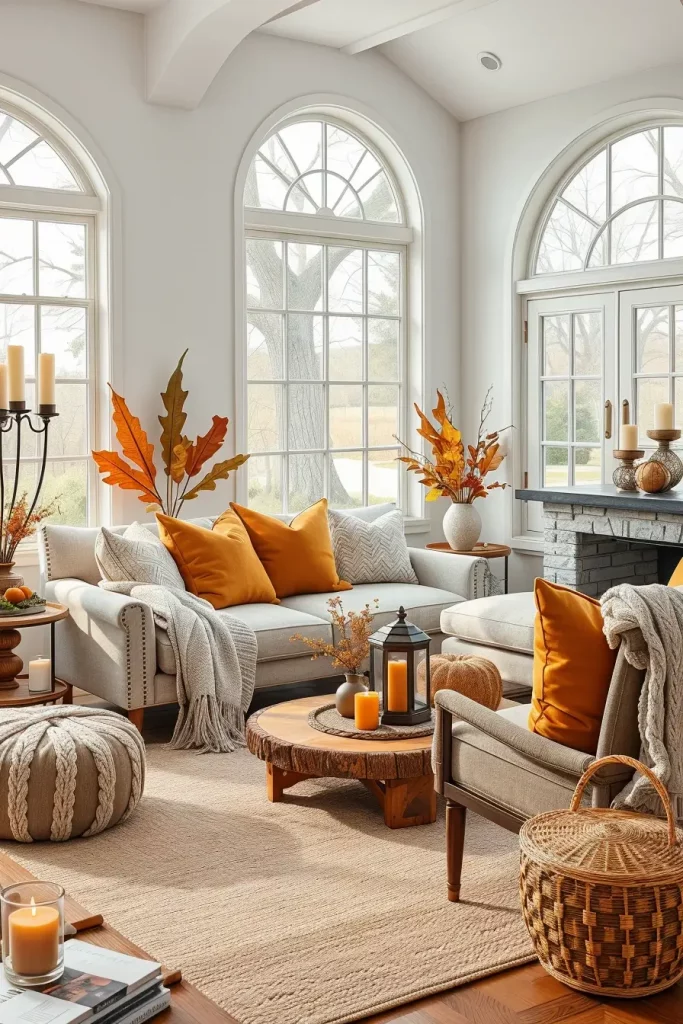
In my own house, I use this philosophy, and I believe that seasonal home decoration helps avoid stagnation. Joanna Gaines of Magnolia fame says it best, stating that seasonal updates “bring joy and intention to living spaces” which makes mindful living easier.
Perhaps off-season item storage could be improved. Storage pieces like stylish bins or ottomans where off-season items can be stashed adds style to the tidy order. These elements ease transitions.
From modern averments to lavish fabrics and stylish accessories, a keeping room is the epitome of comfort in contemporary homes. Every suggestion offered in the article accompanies framework in order to mesh sophistication with ingenuity. Are there any other details or design aspects you intend to adopt? We invite you to share your comments on how you are planning your dream keeping room because it certainly interests us.
